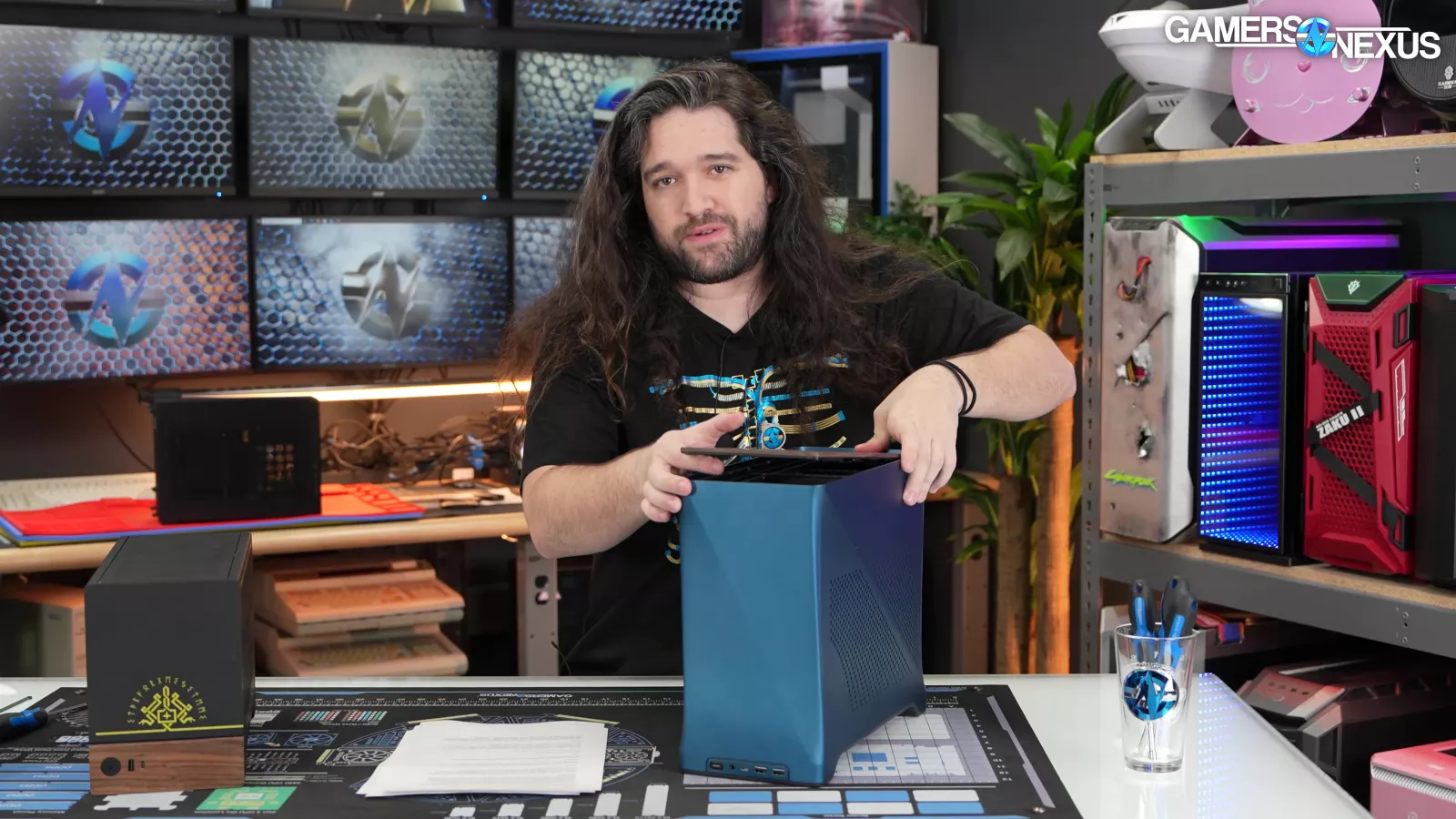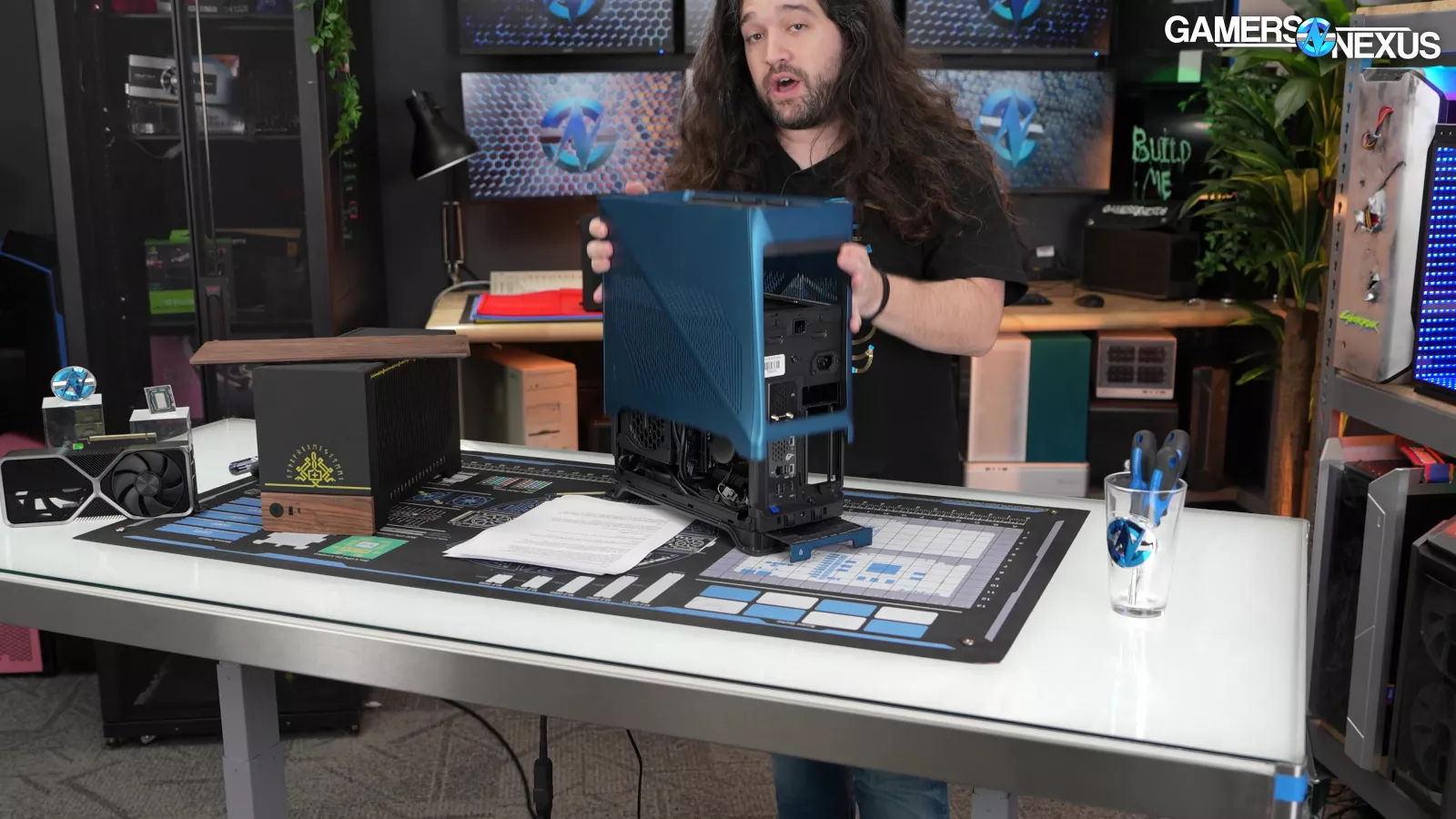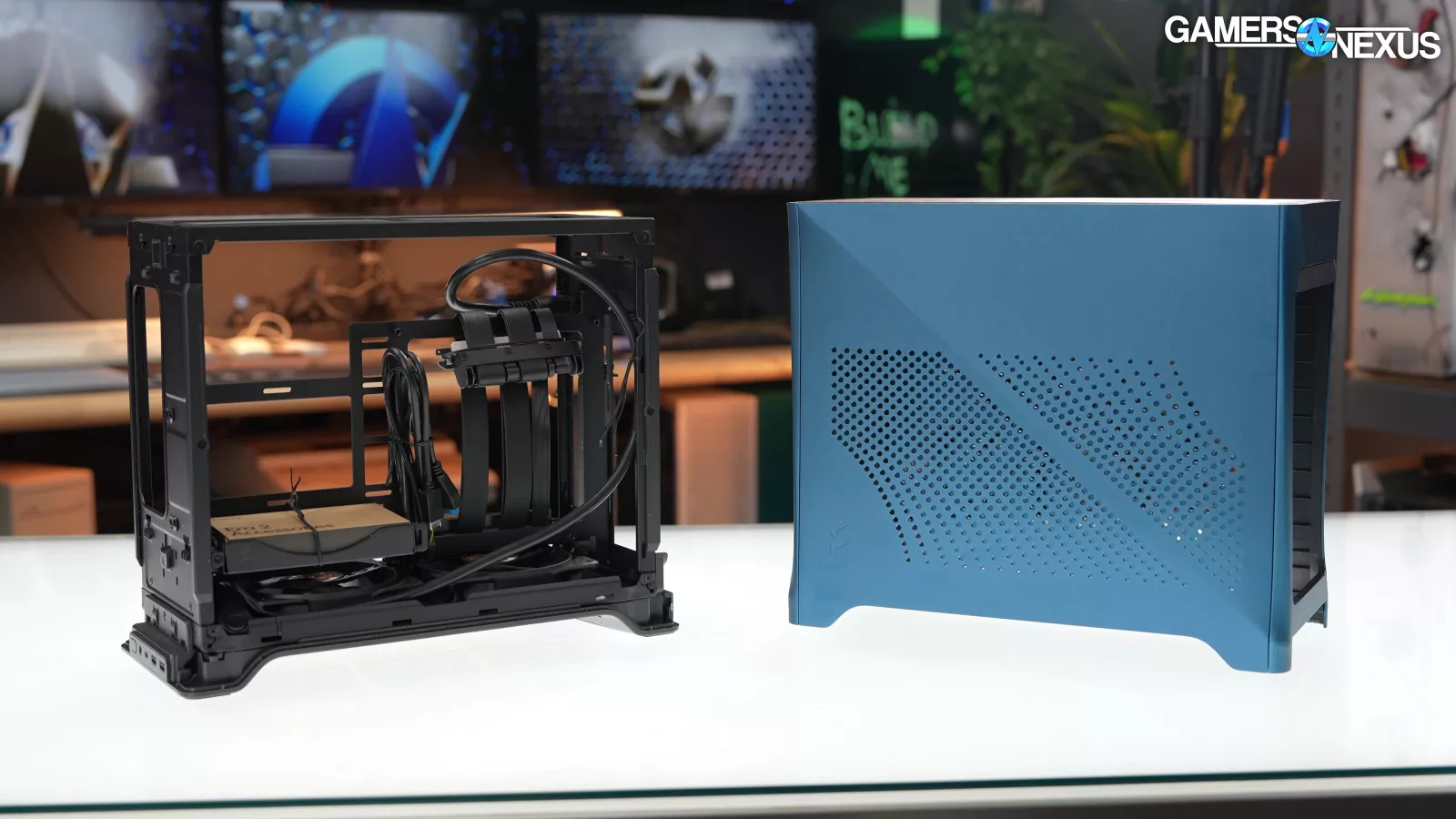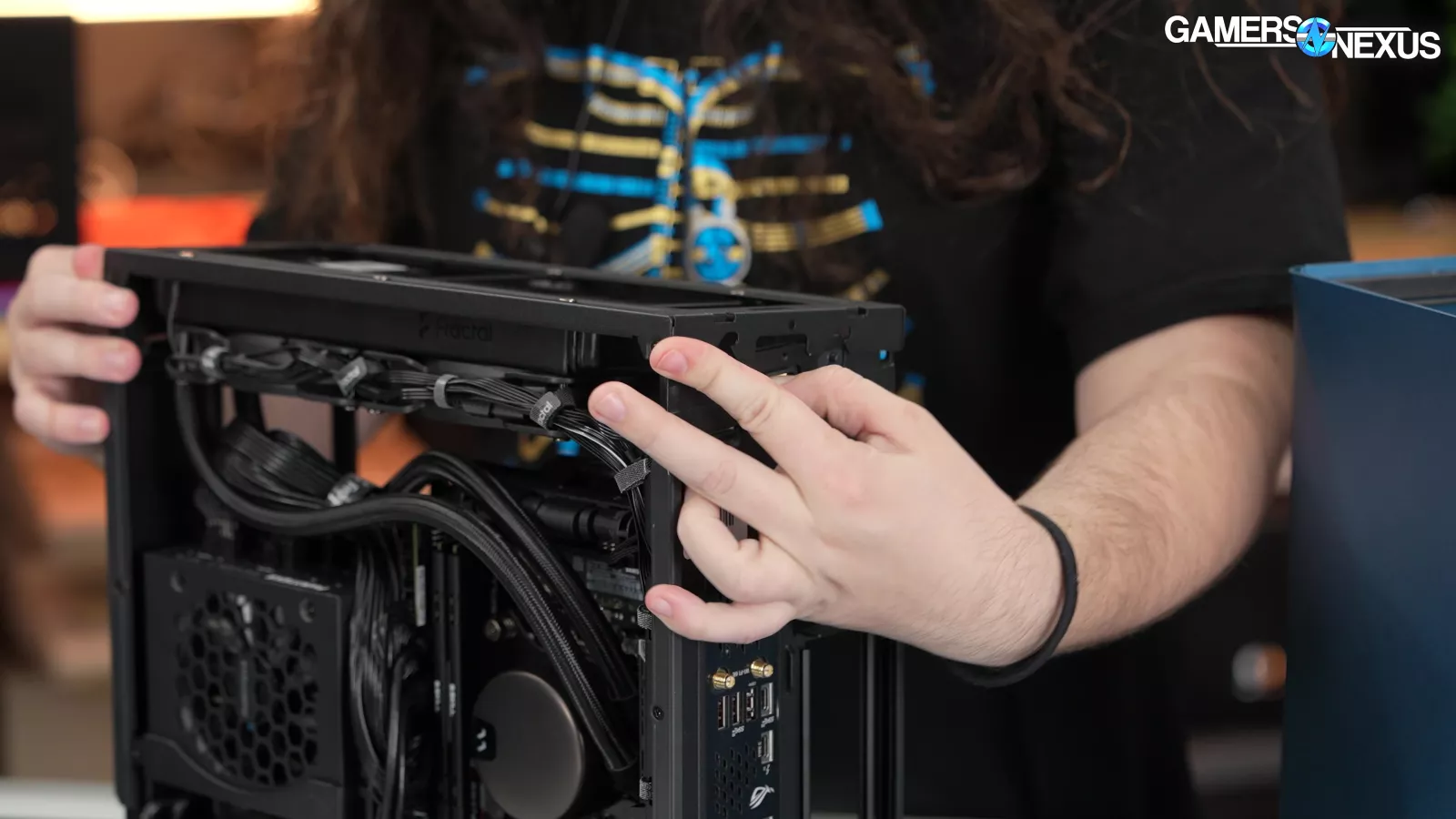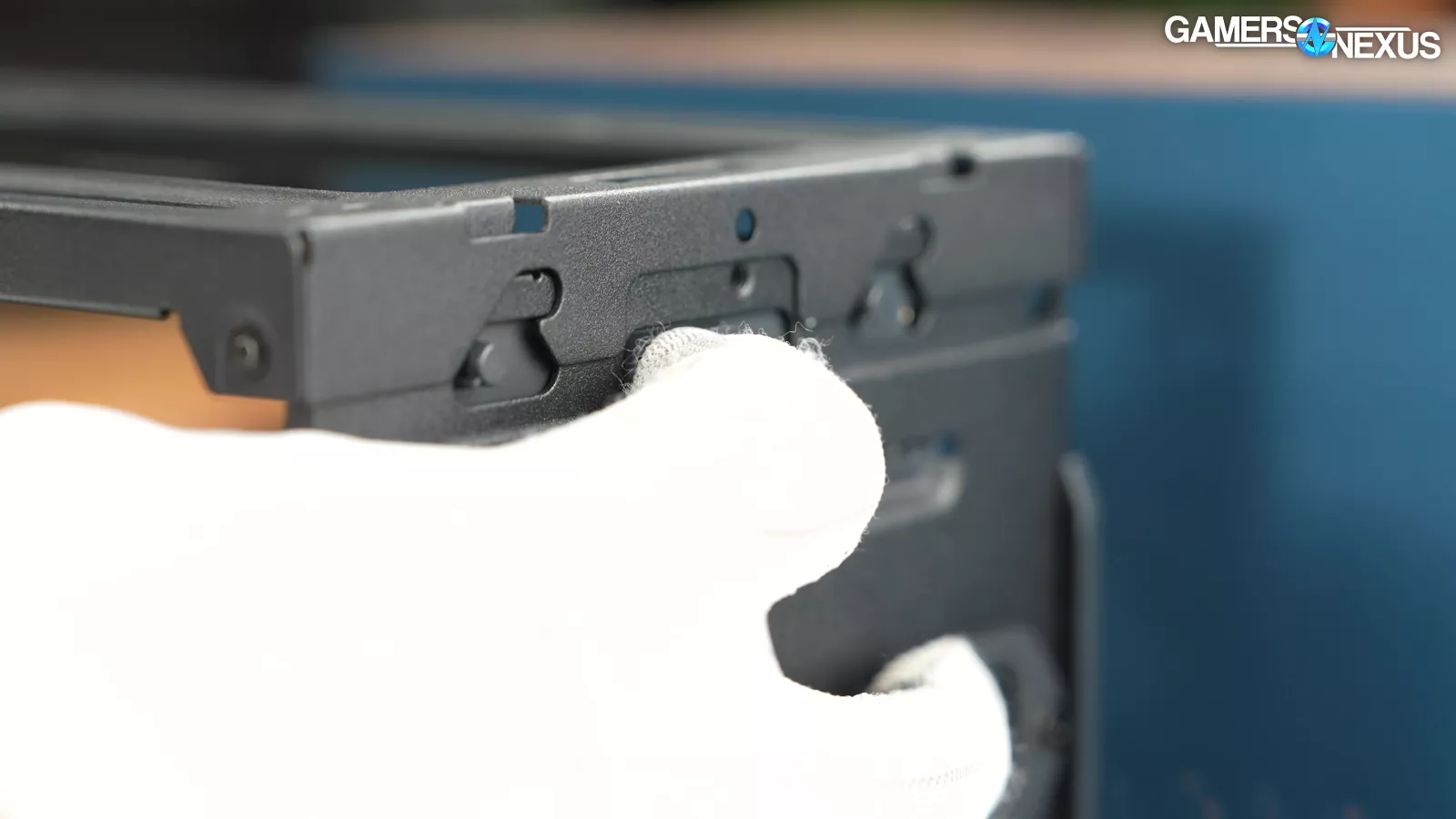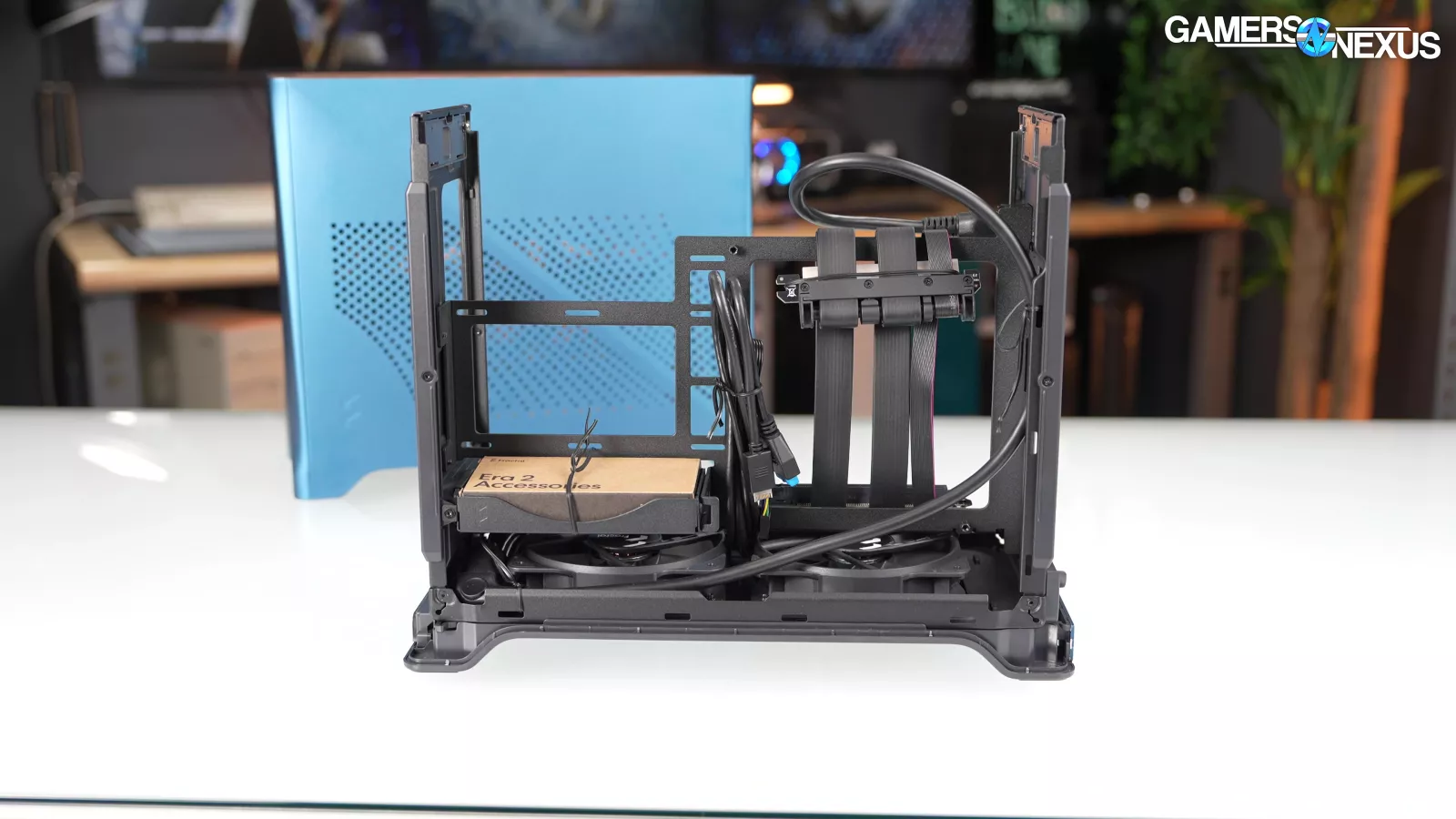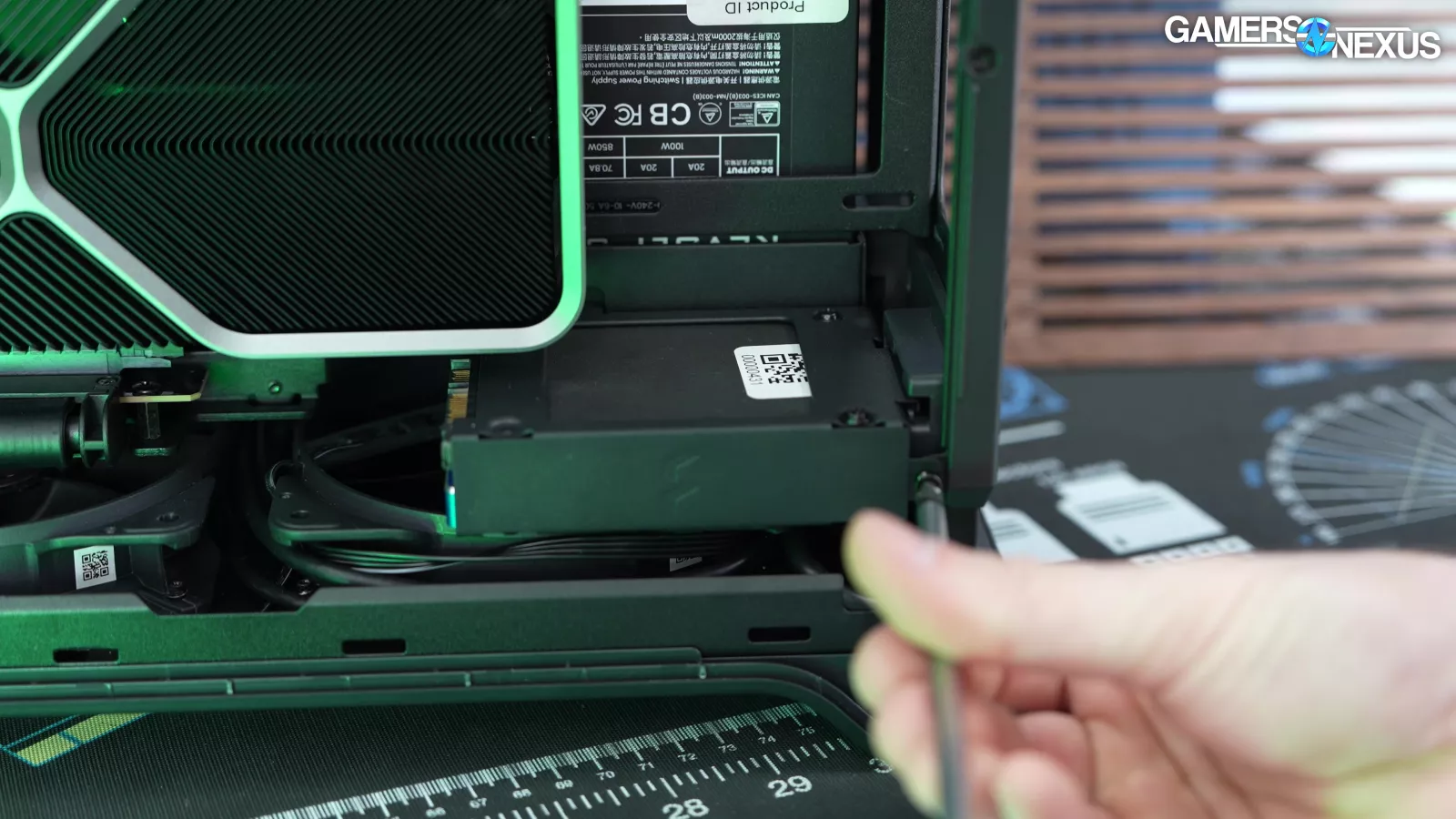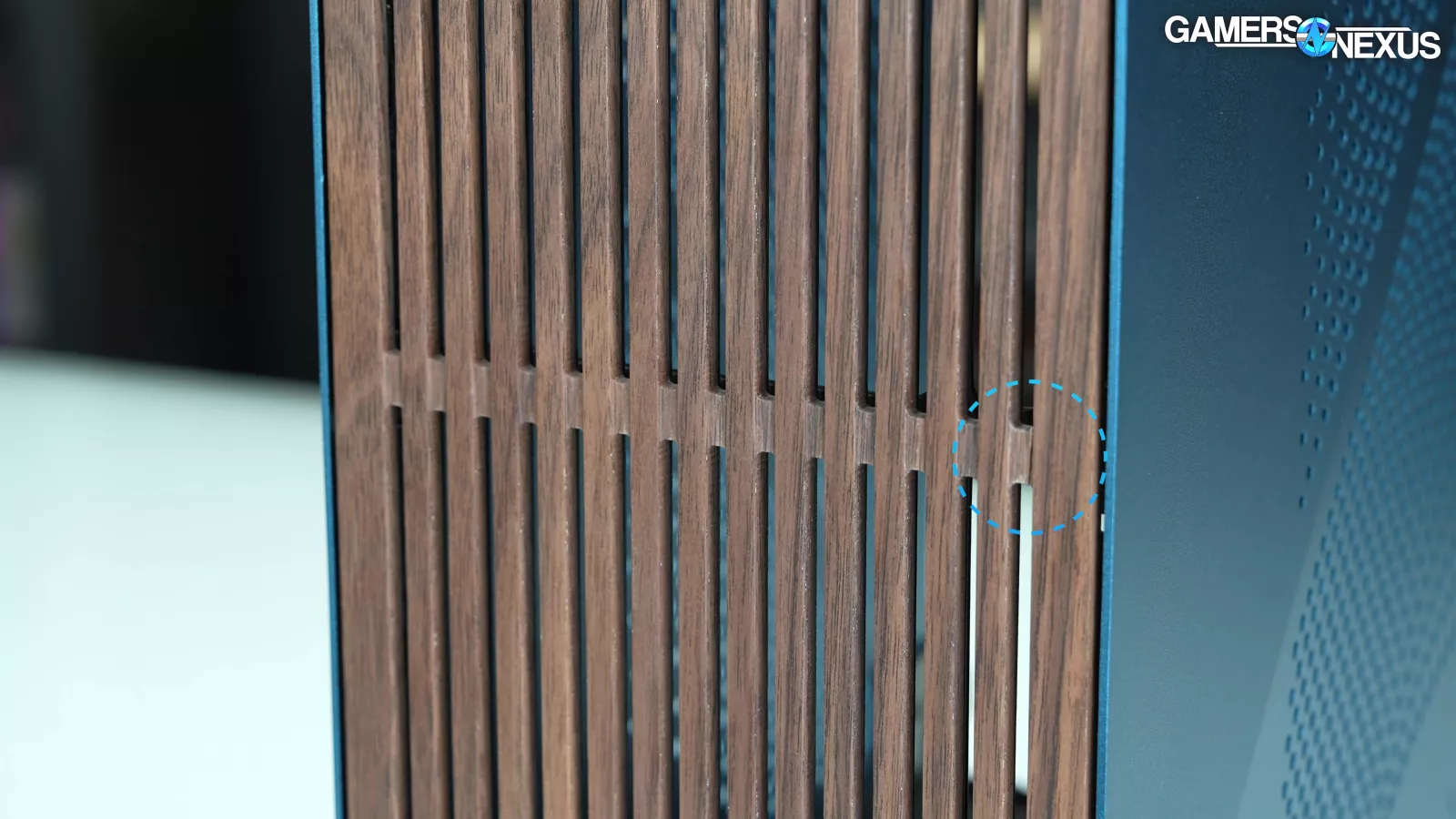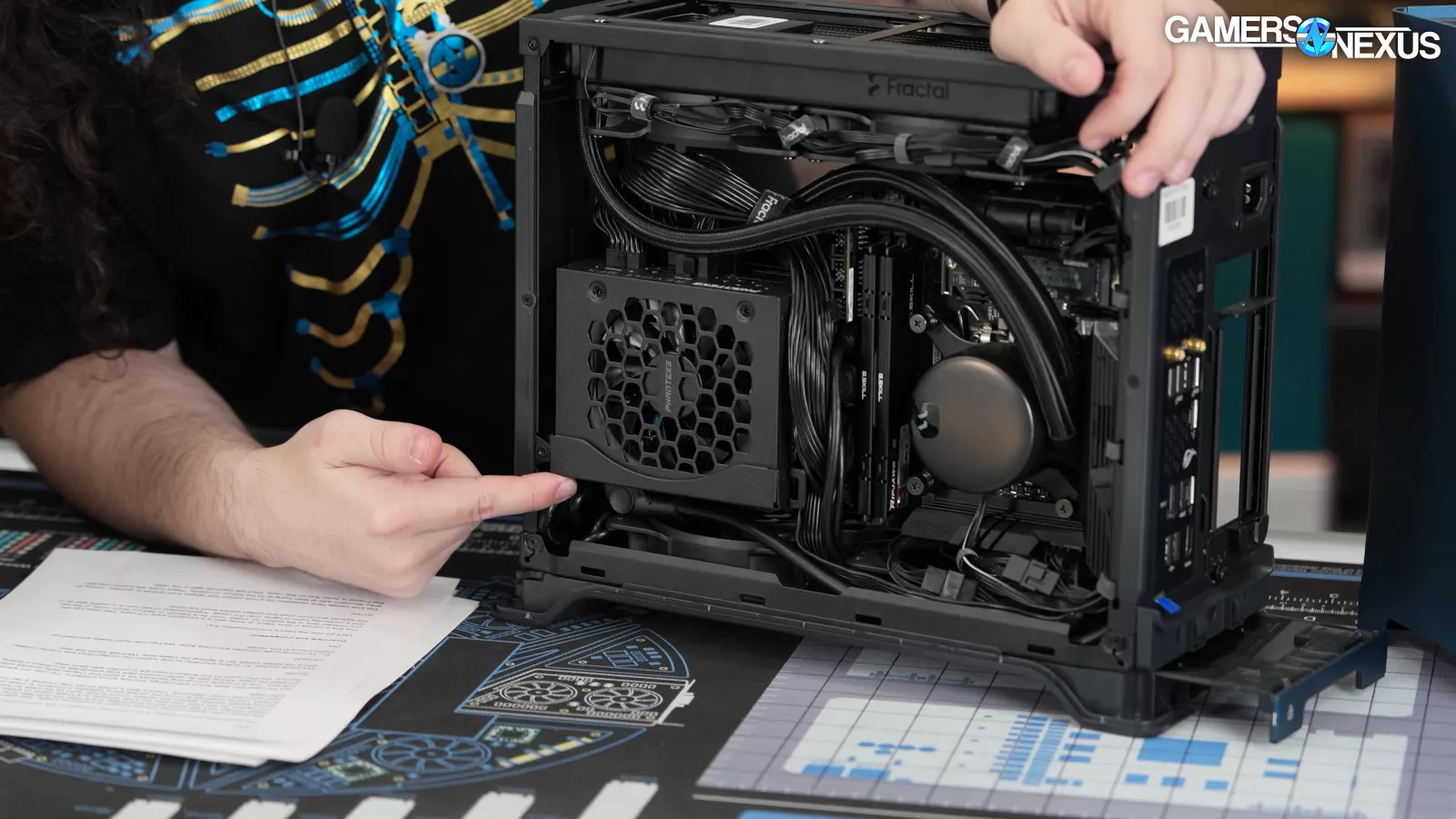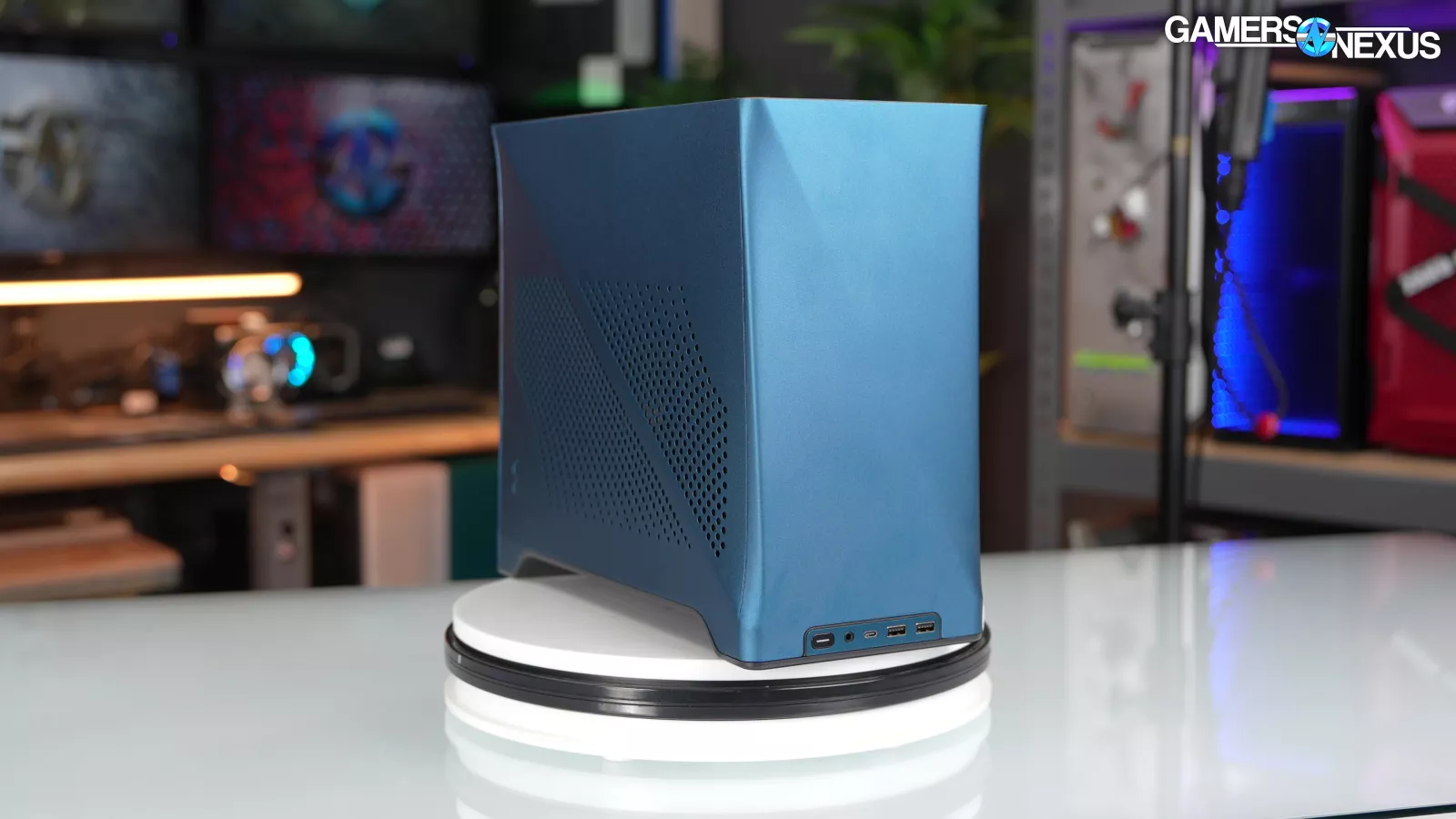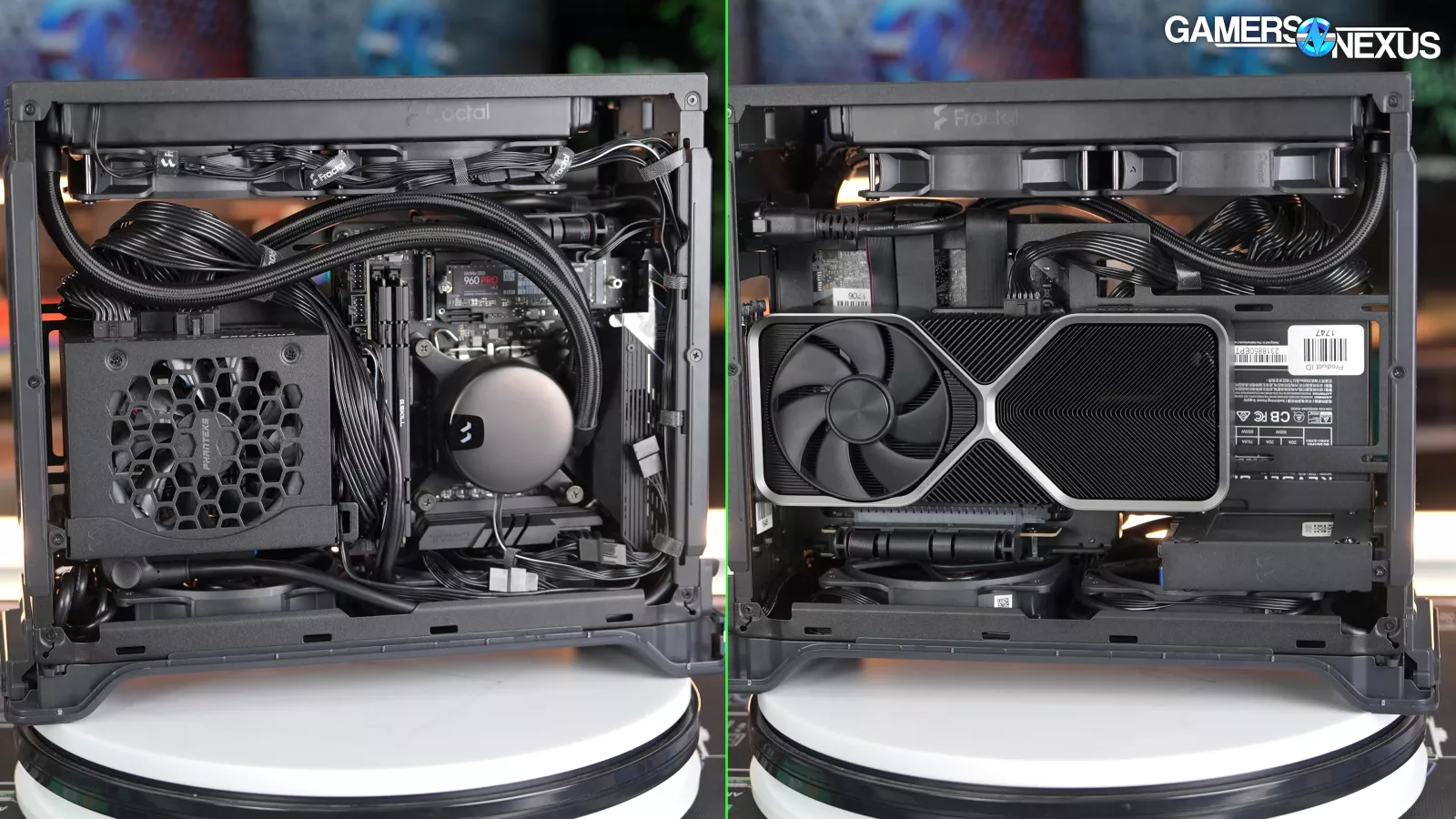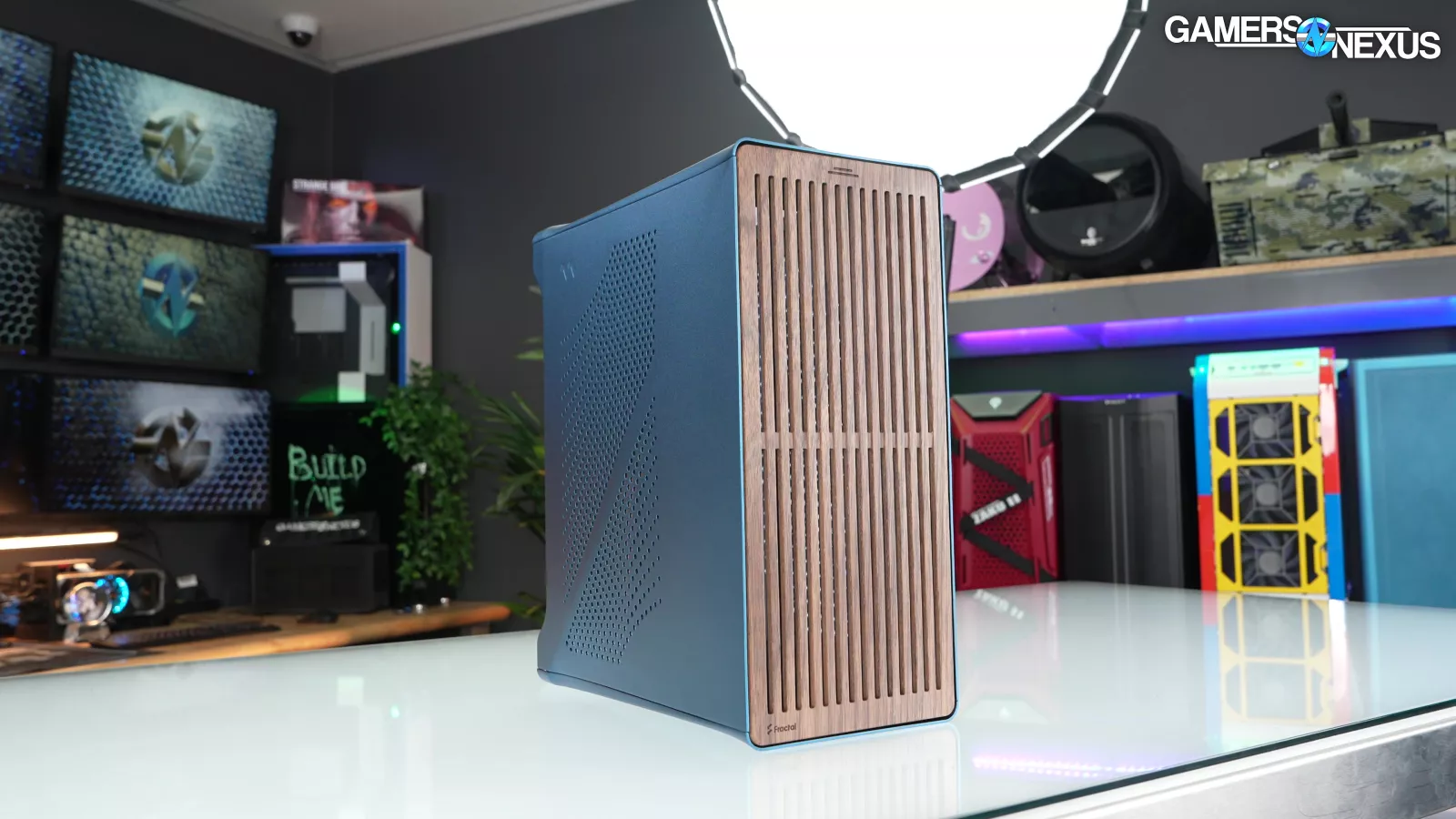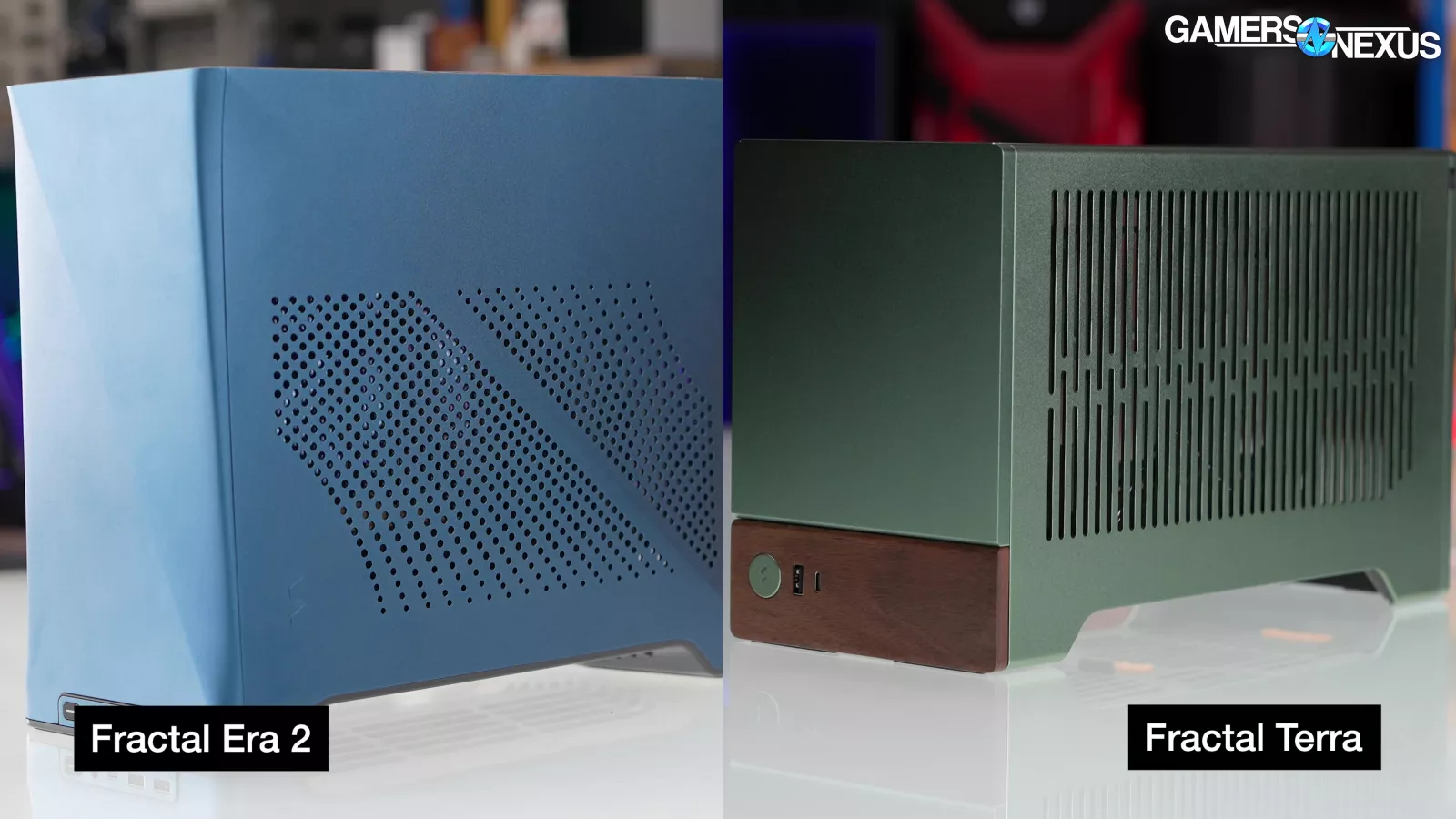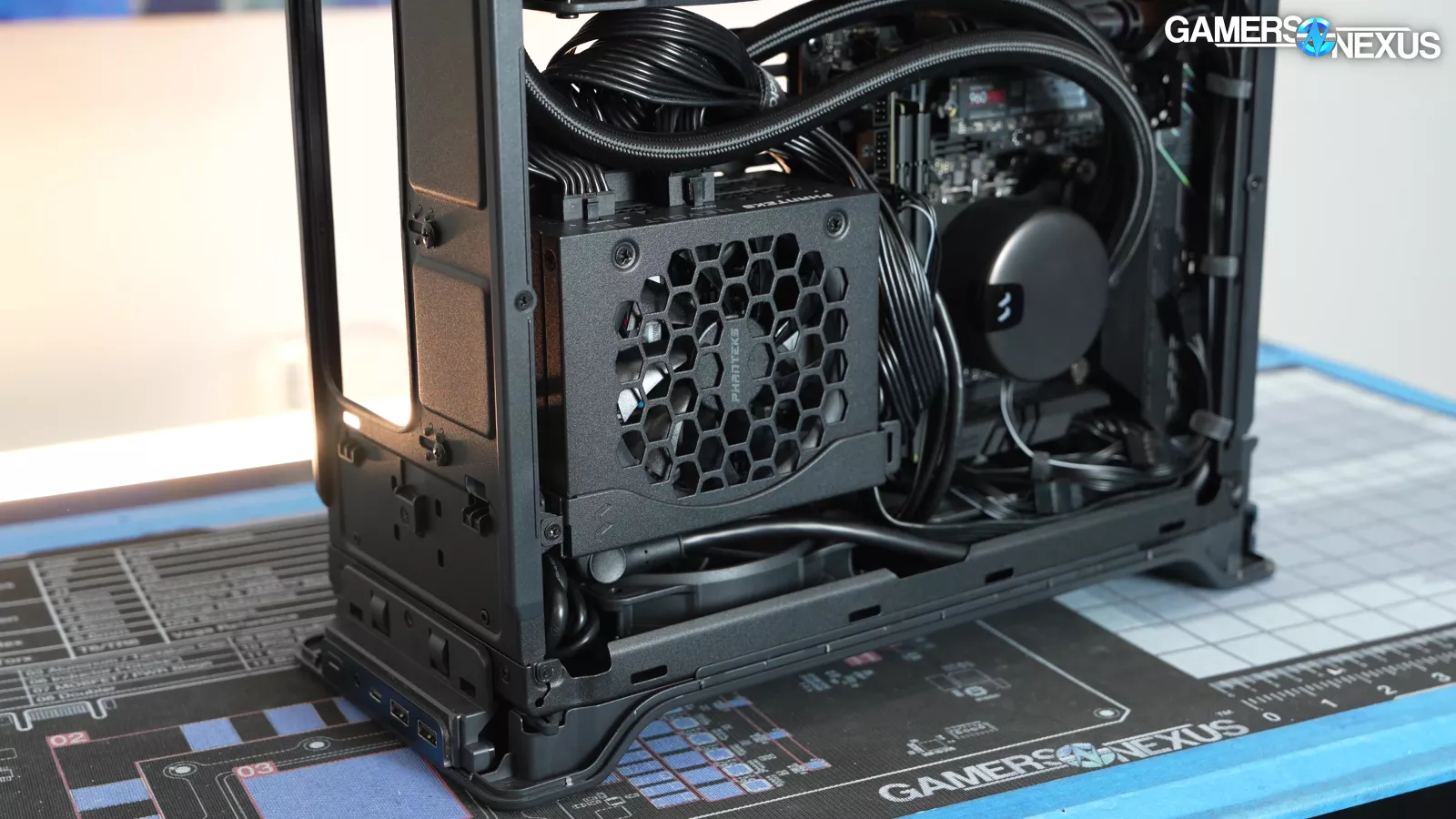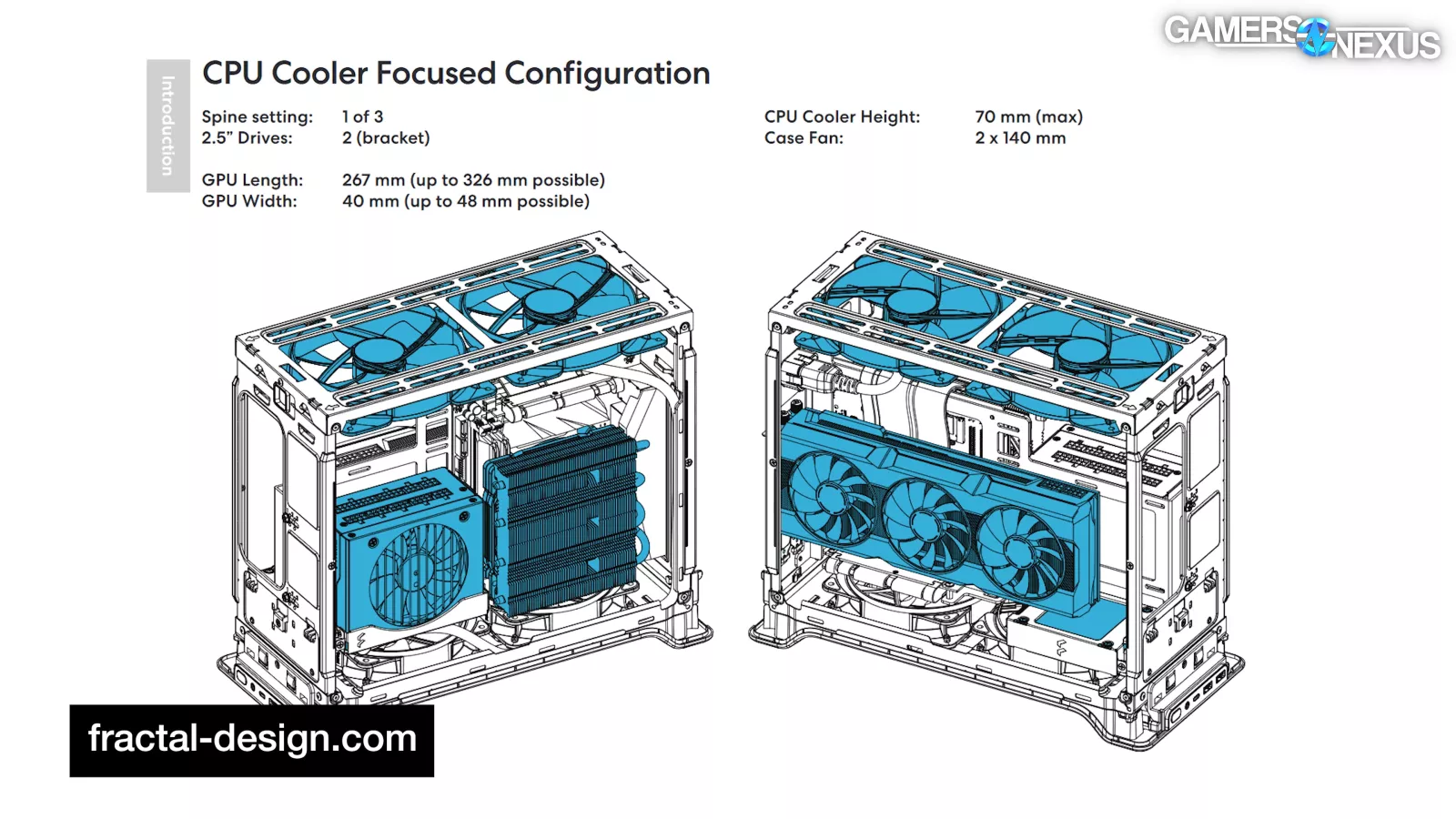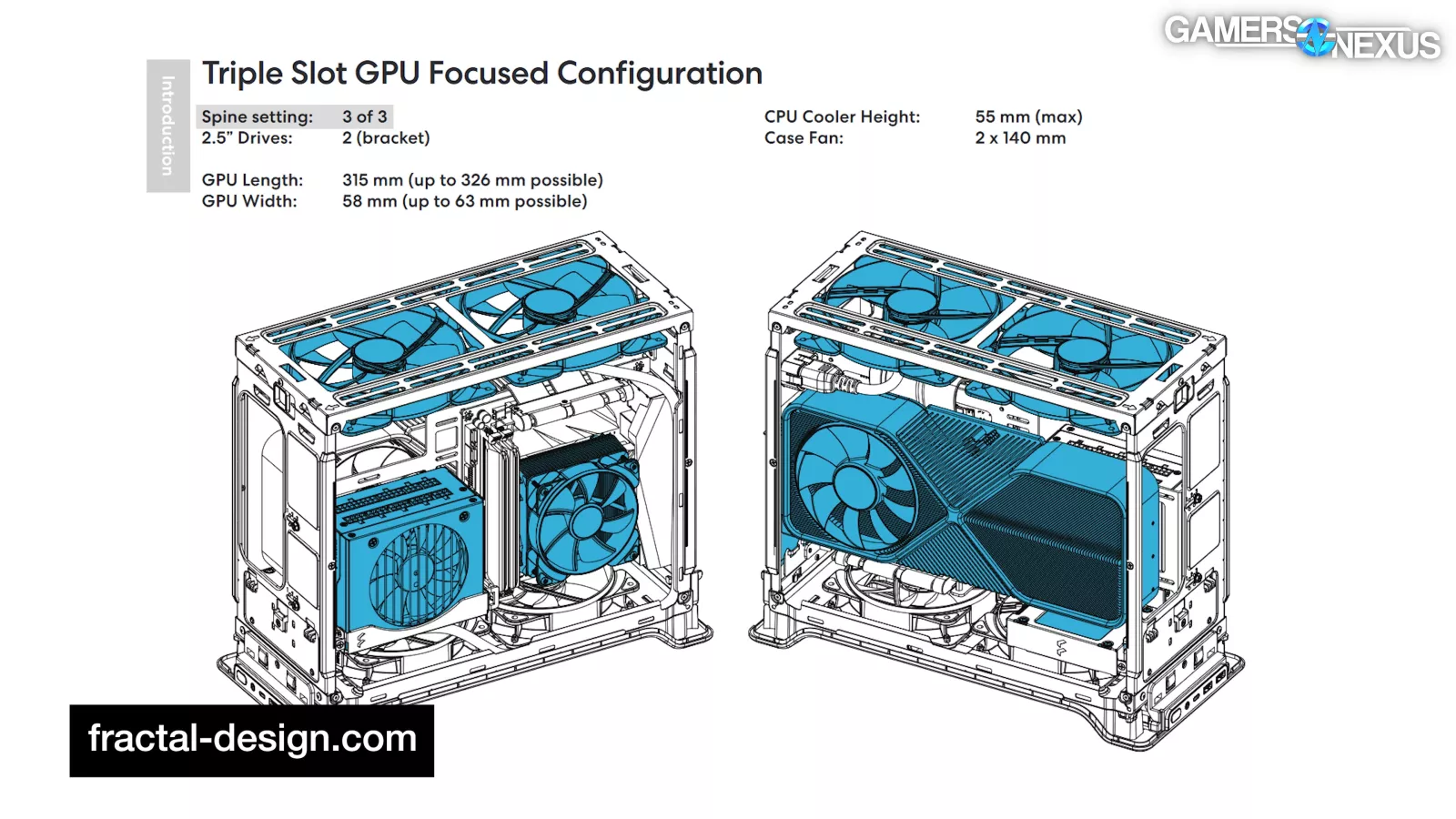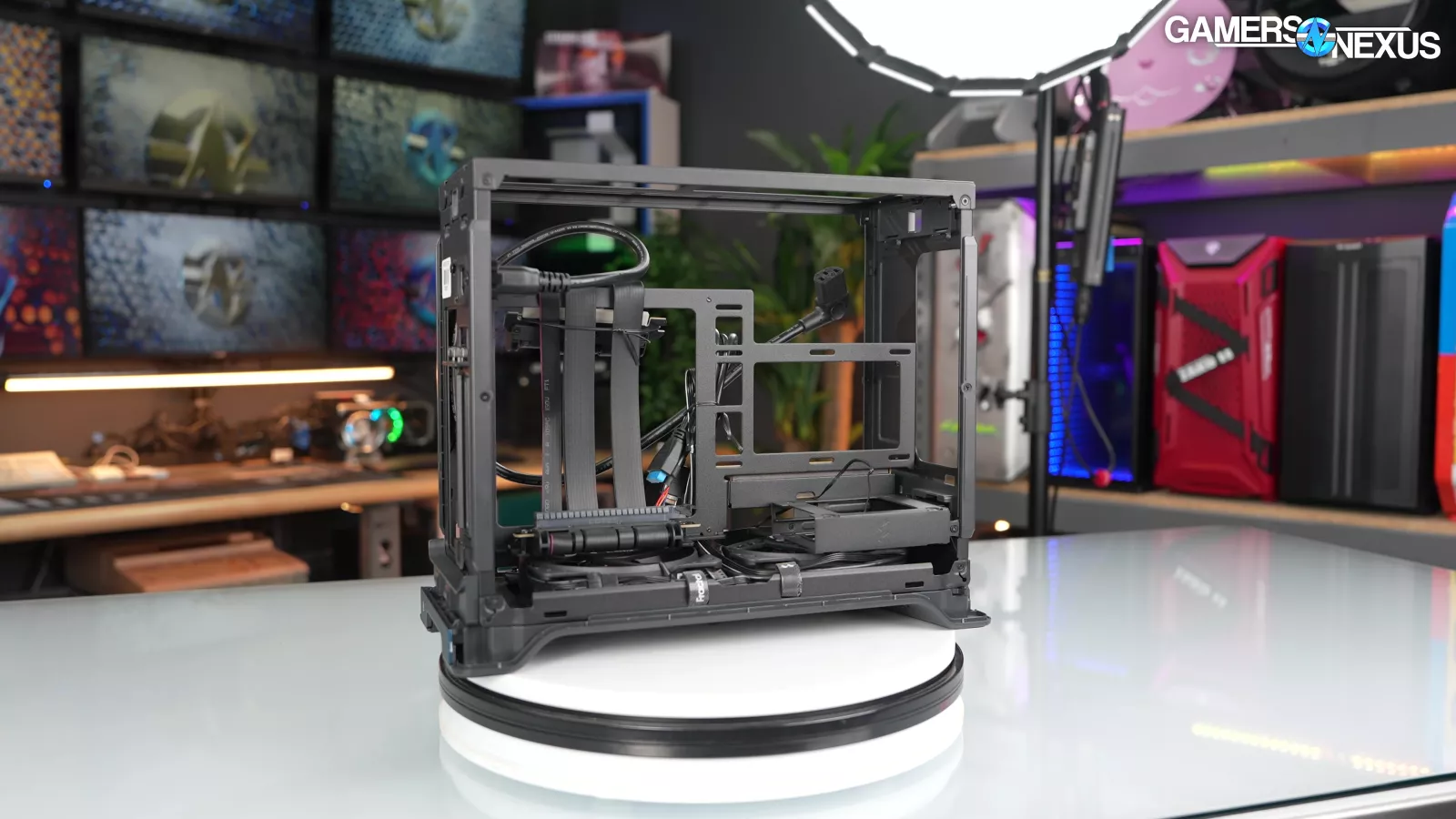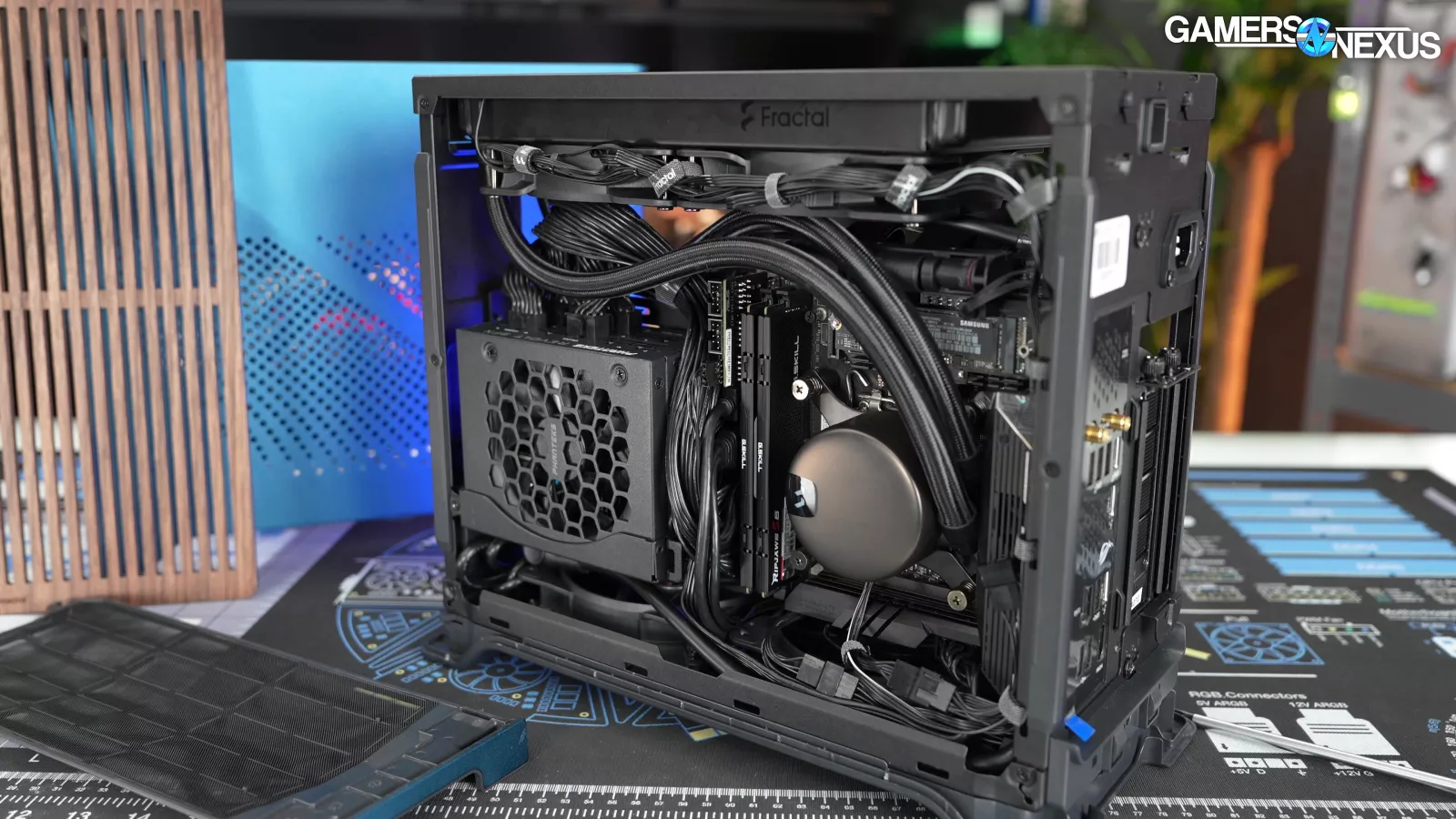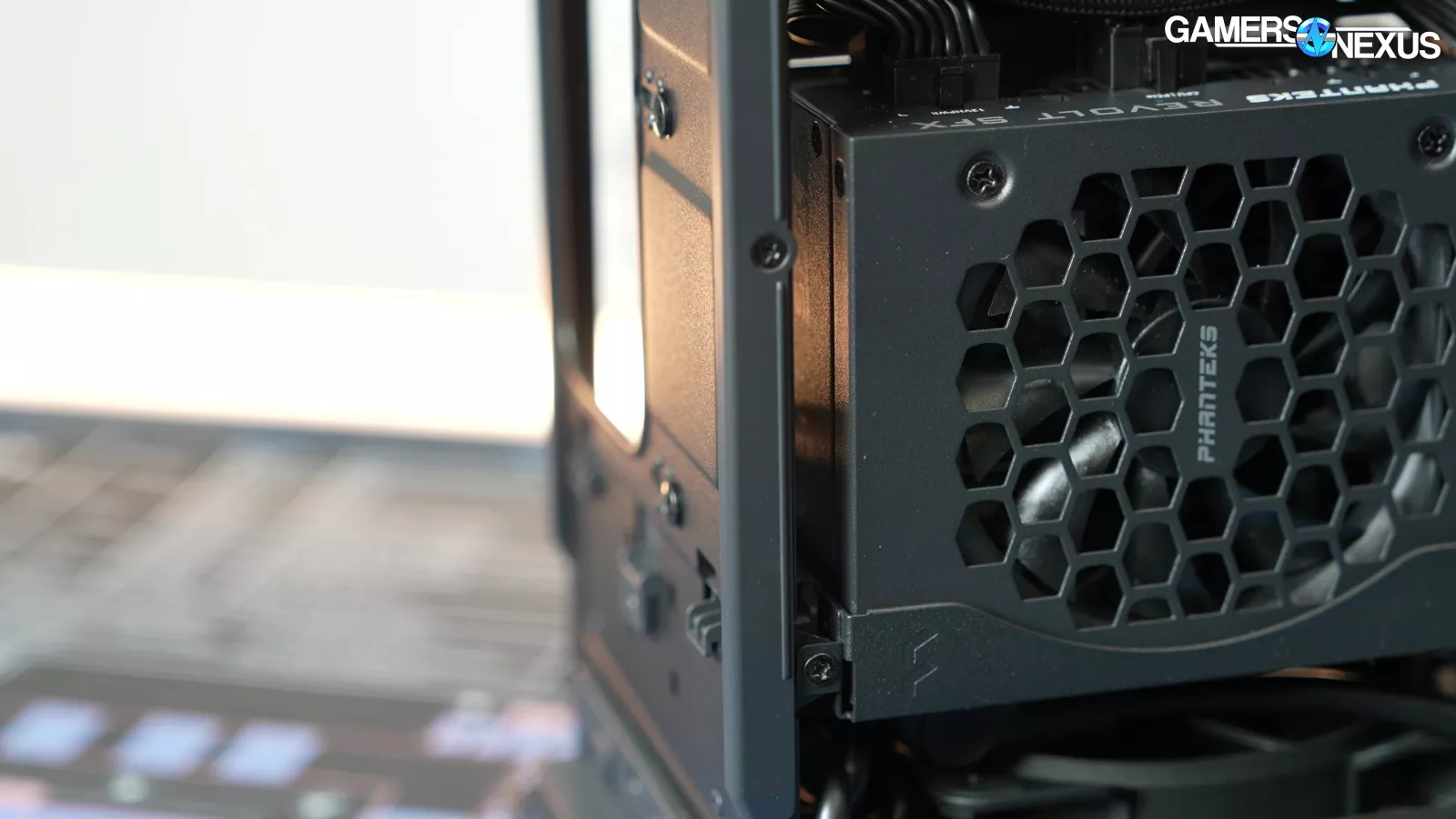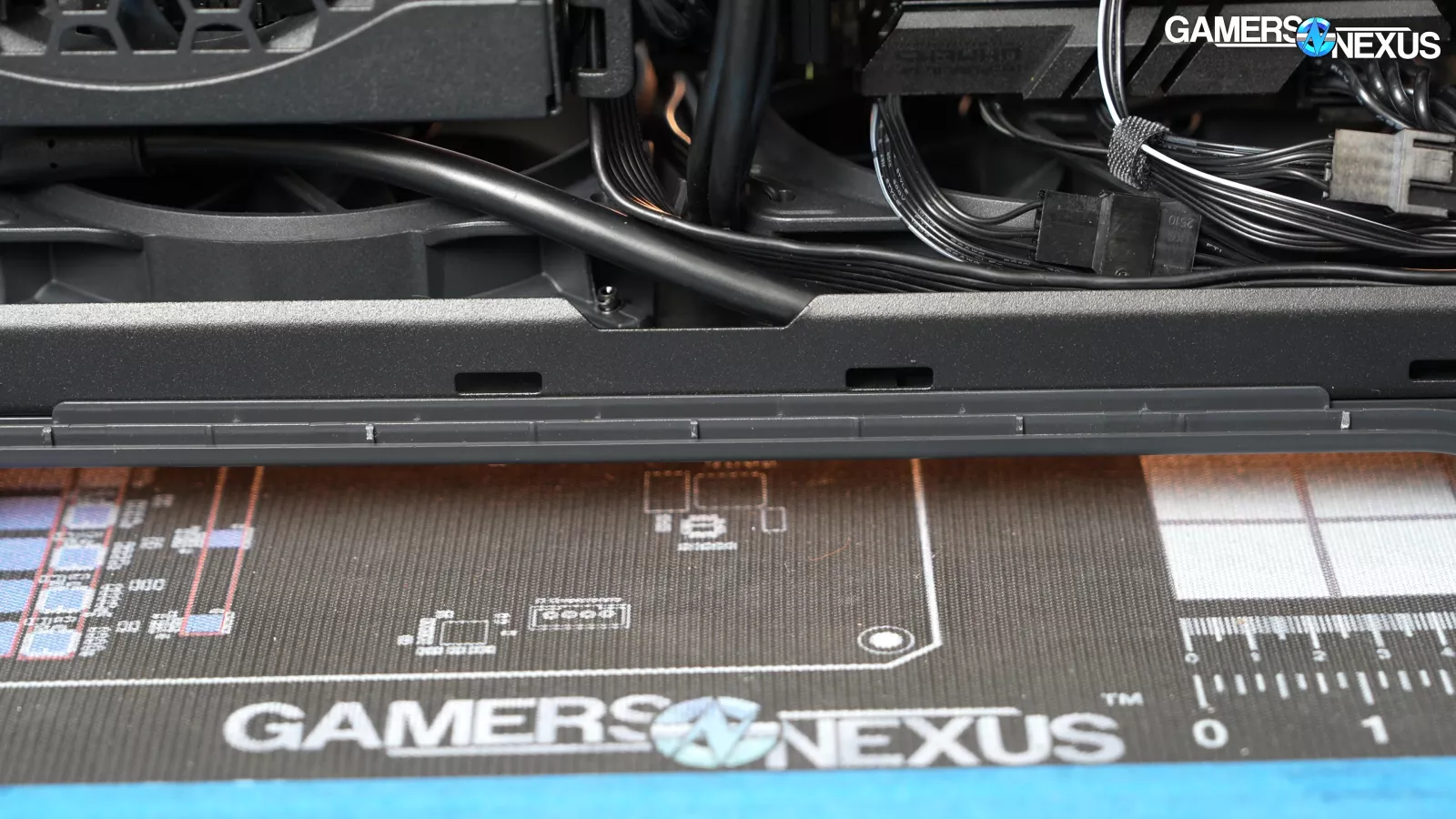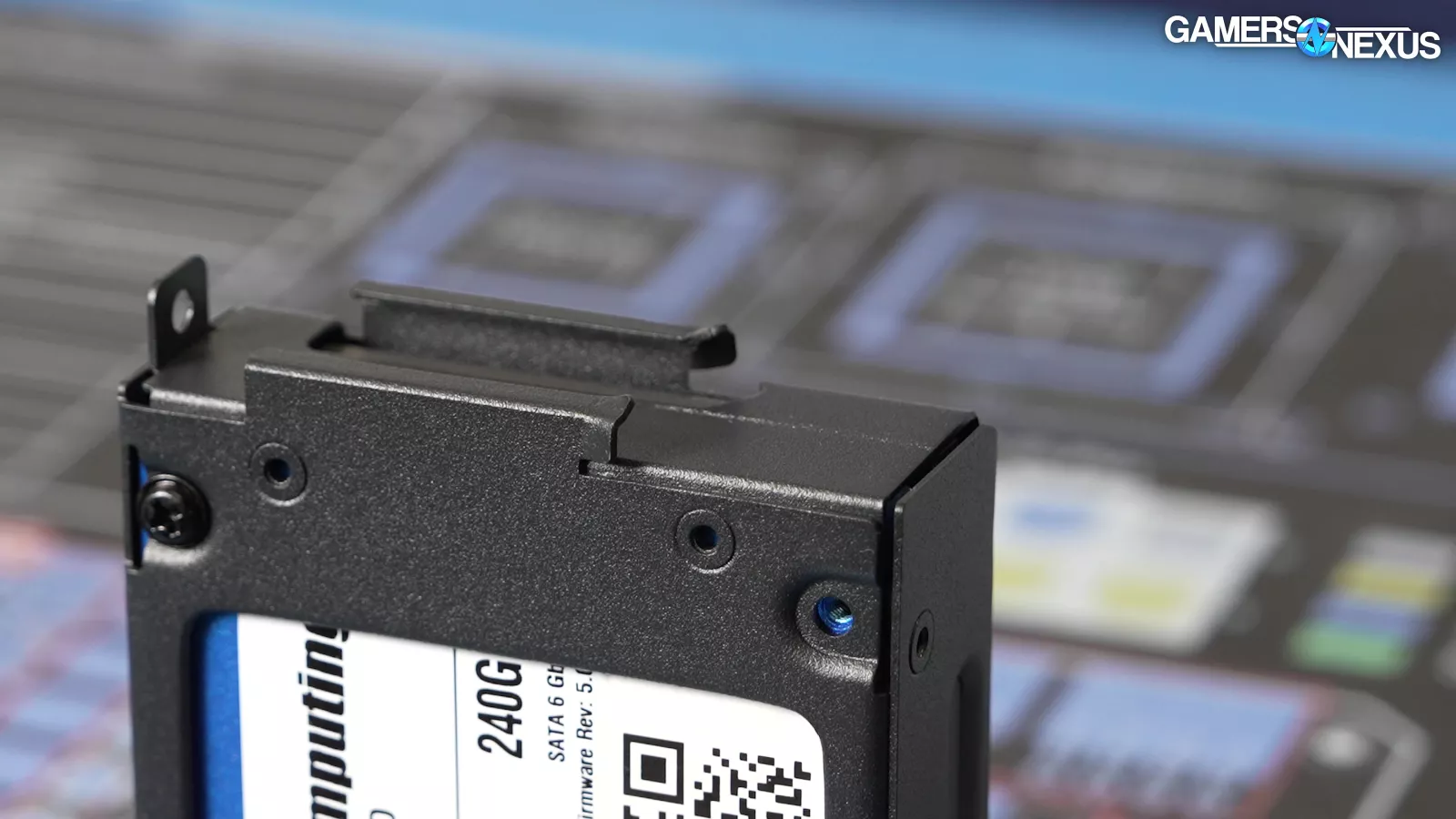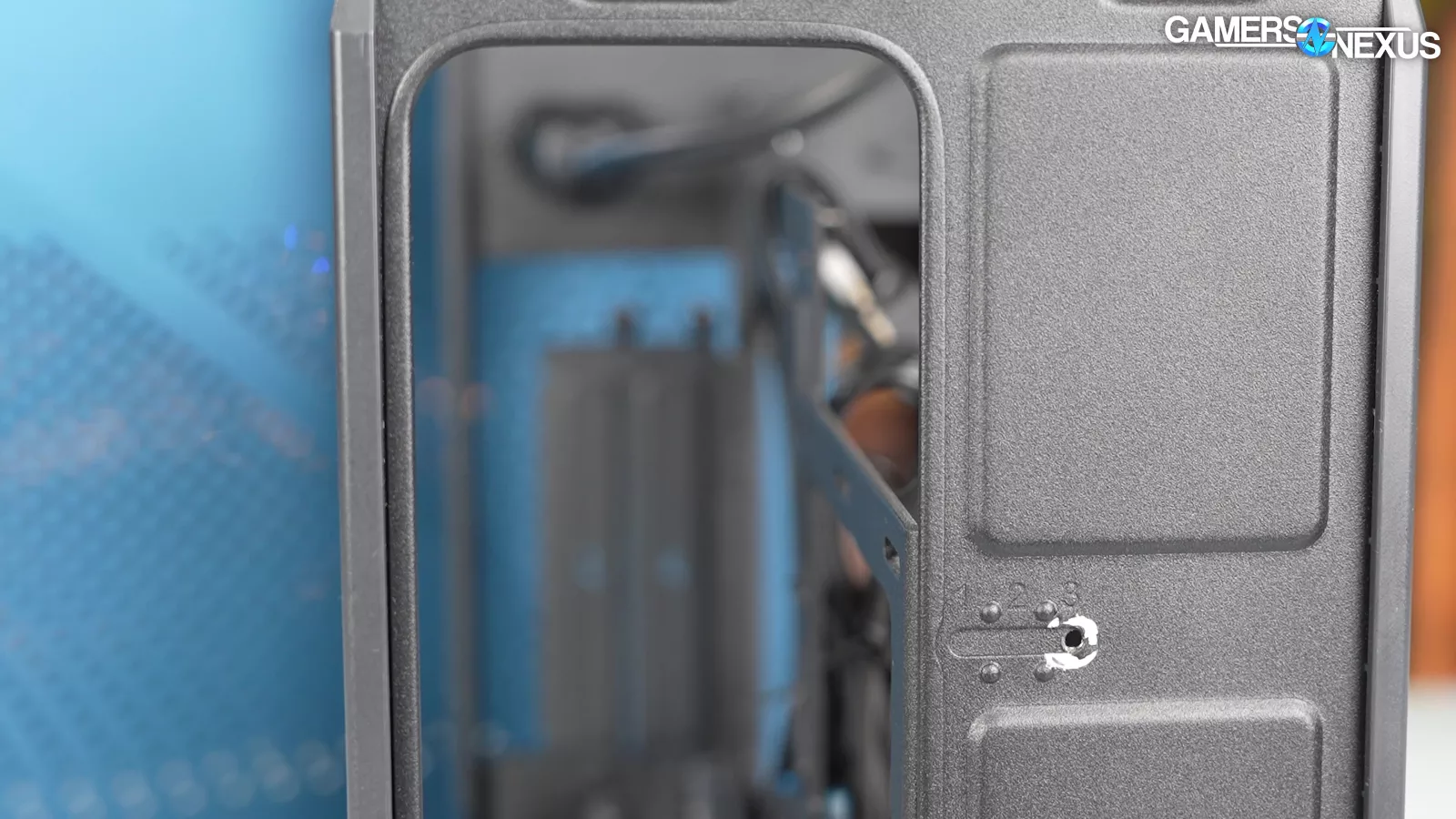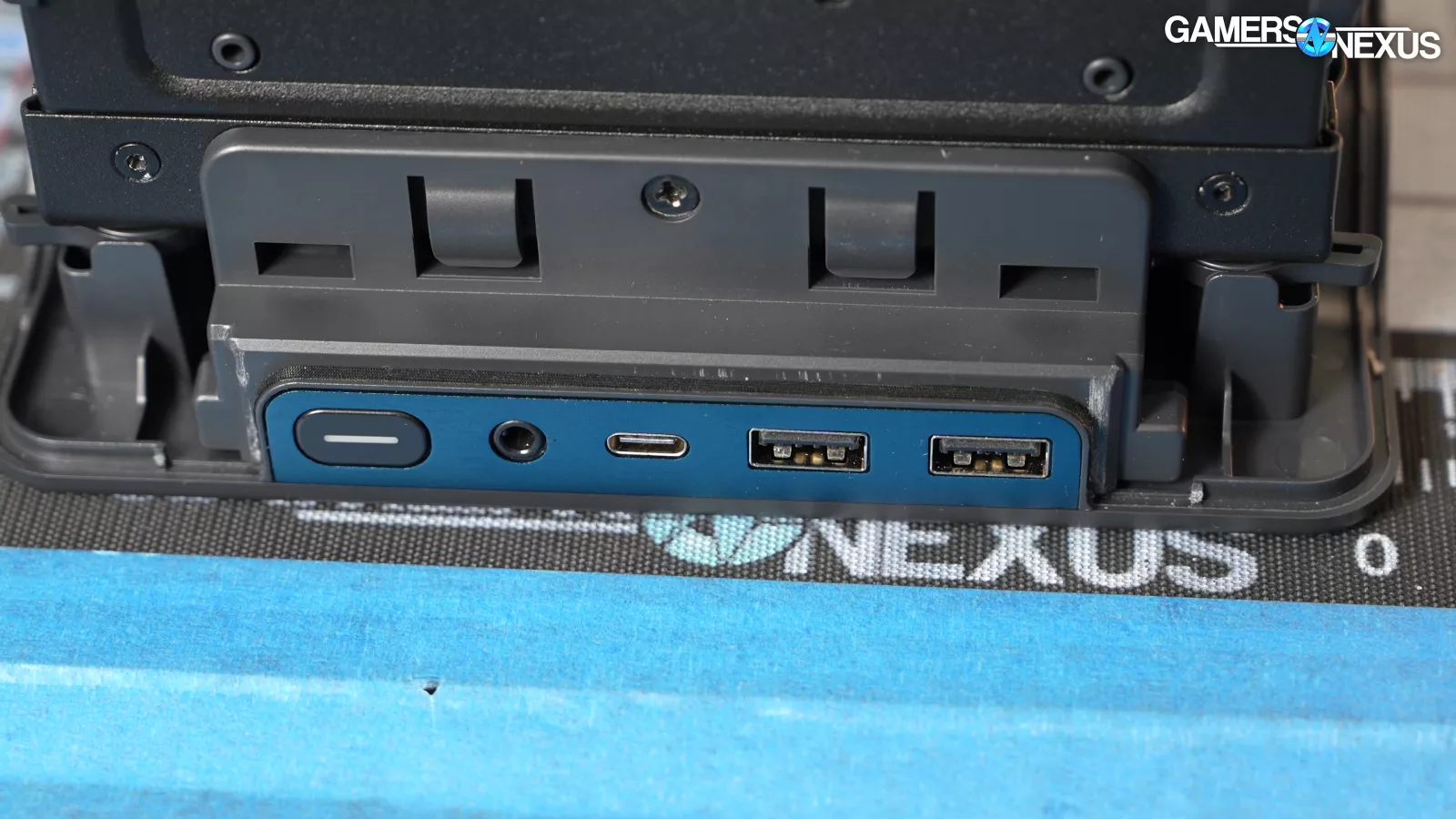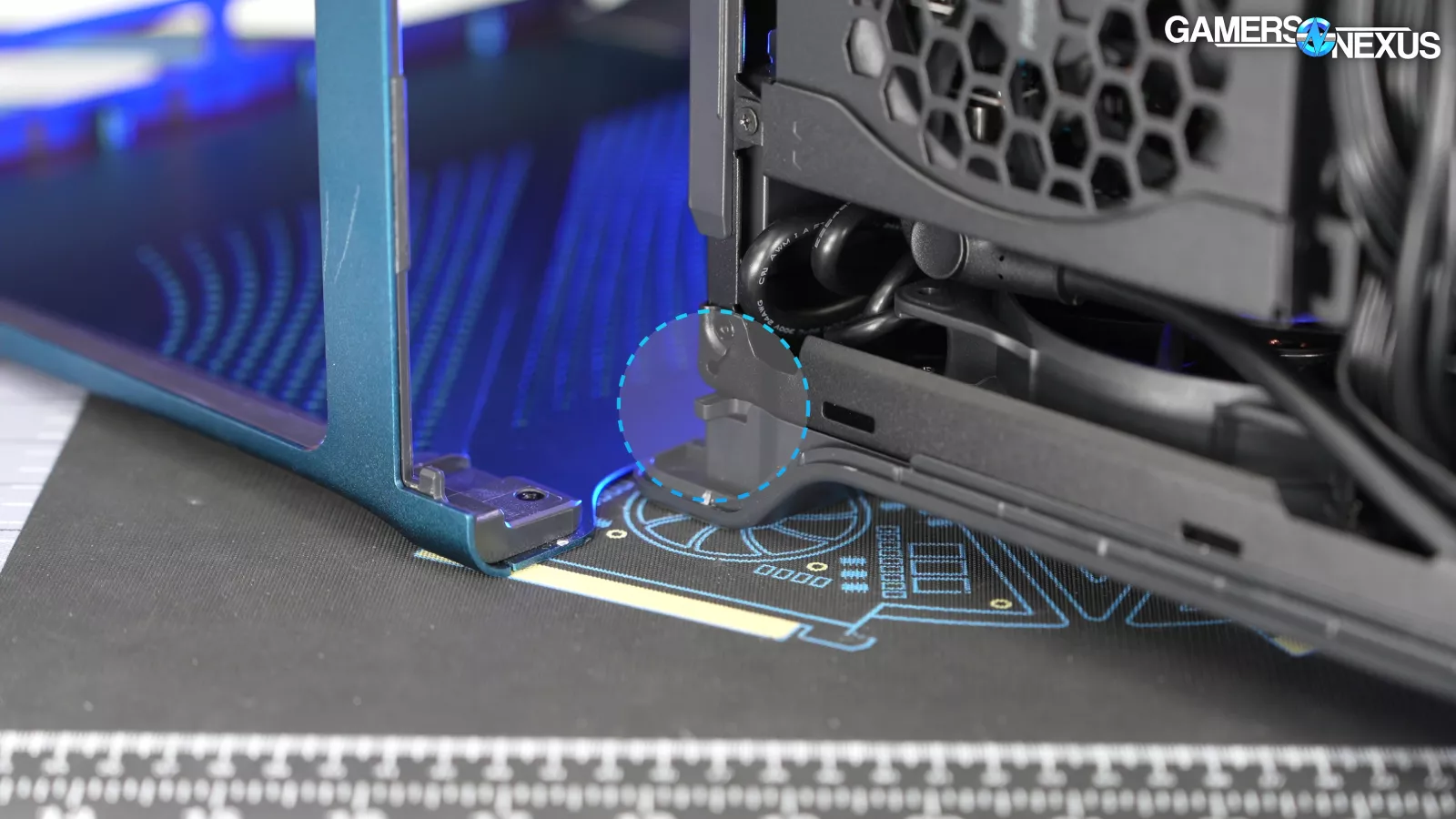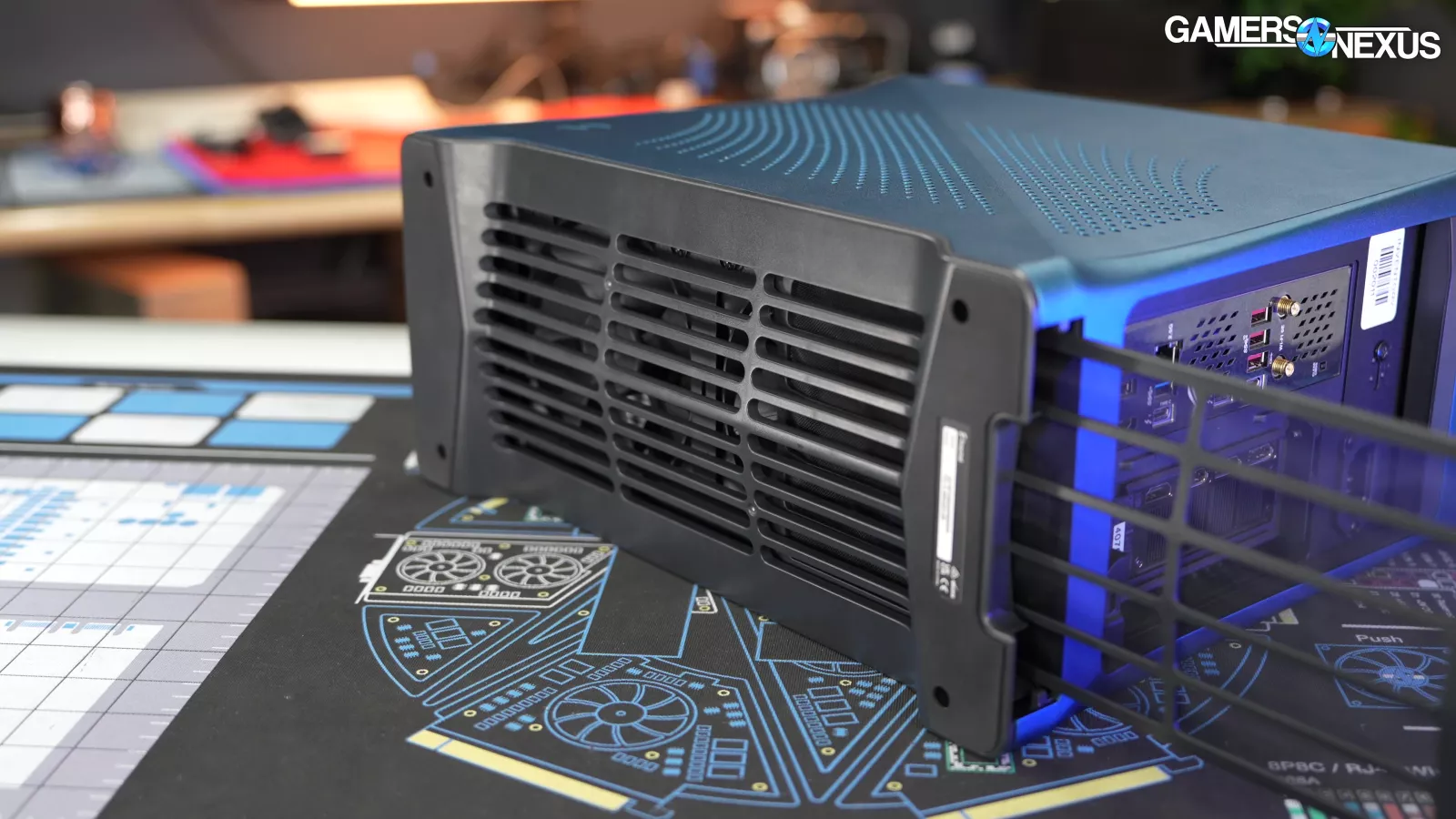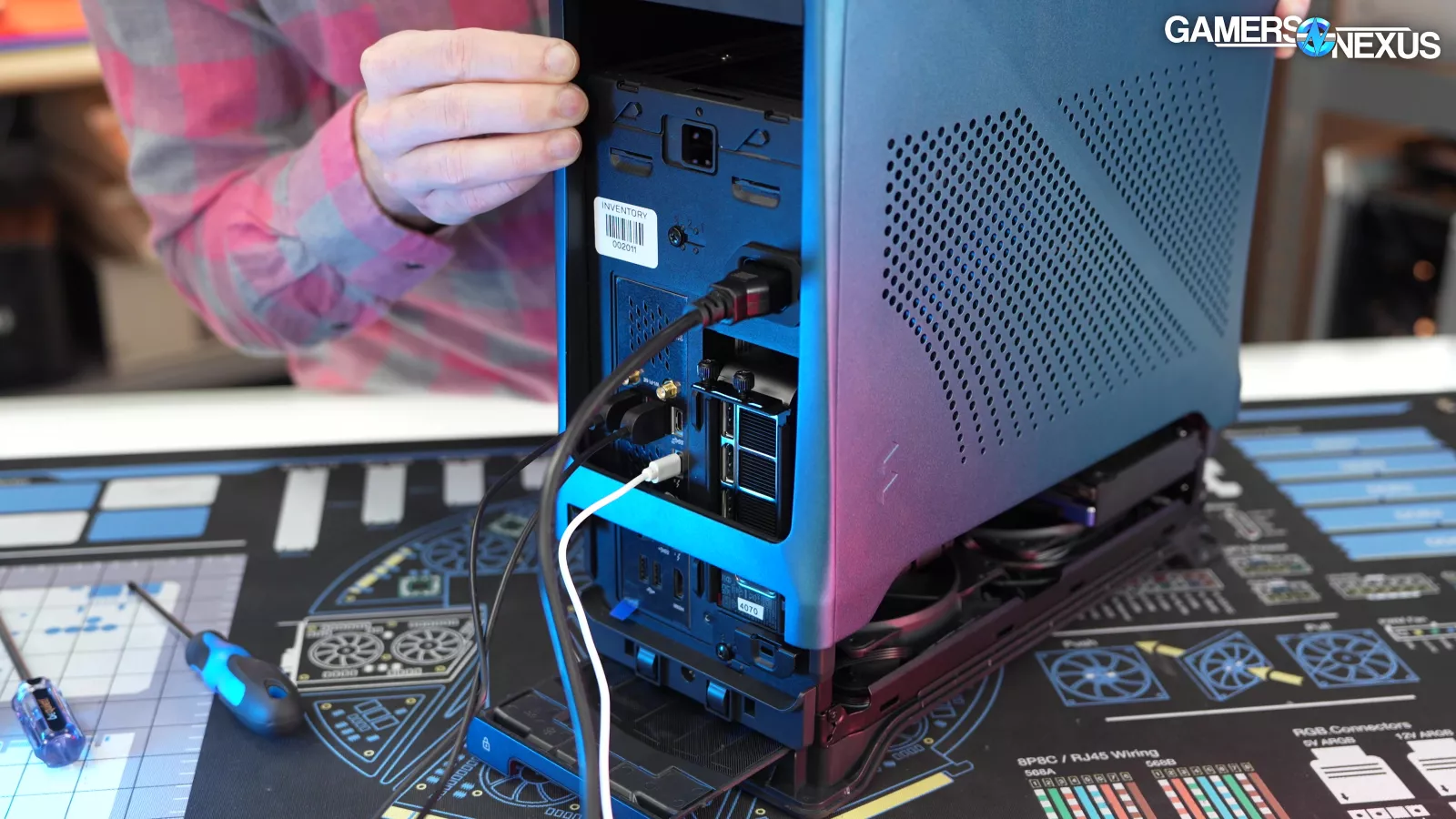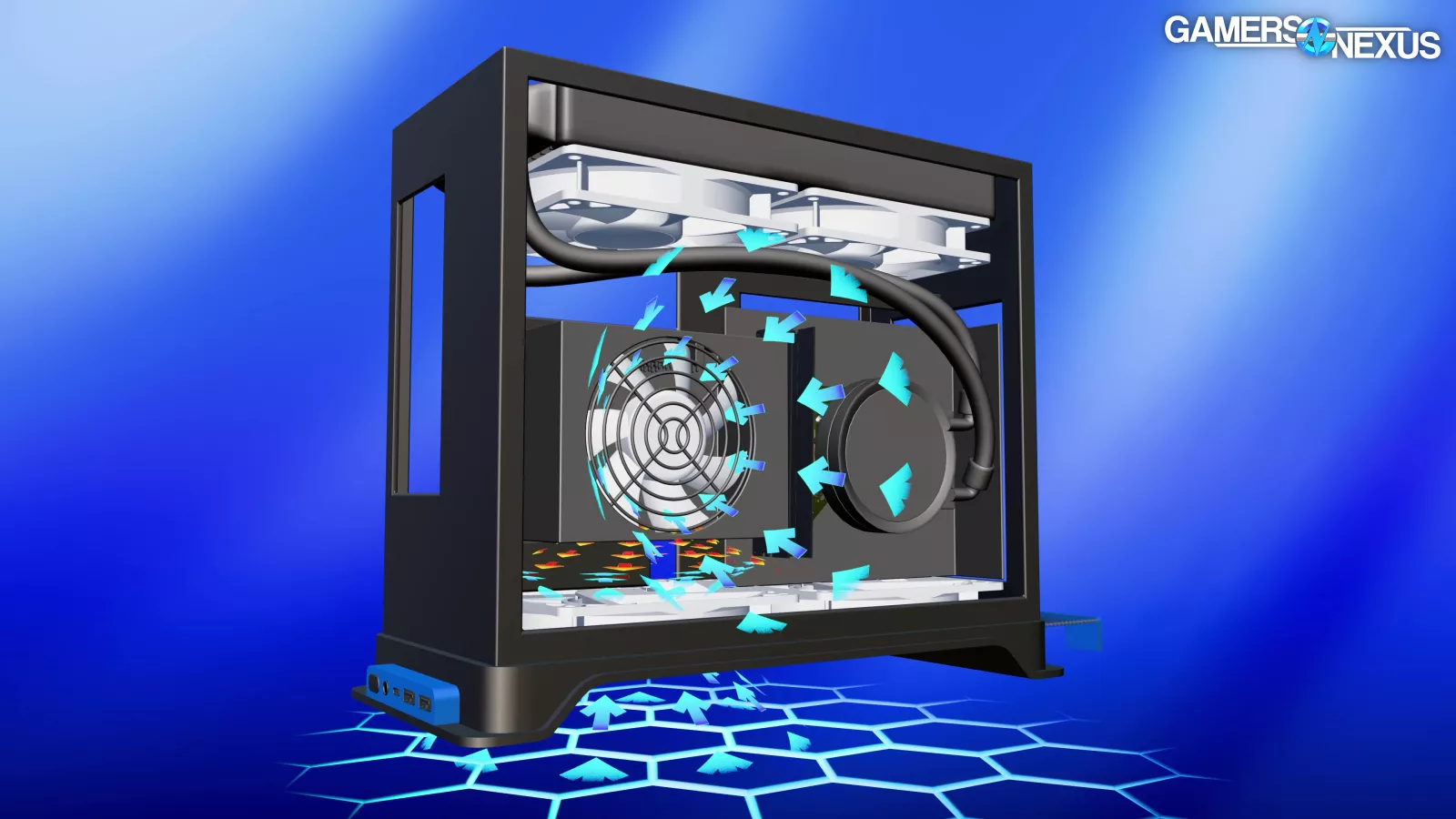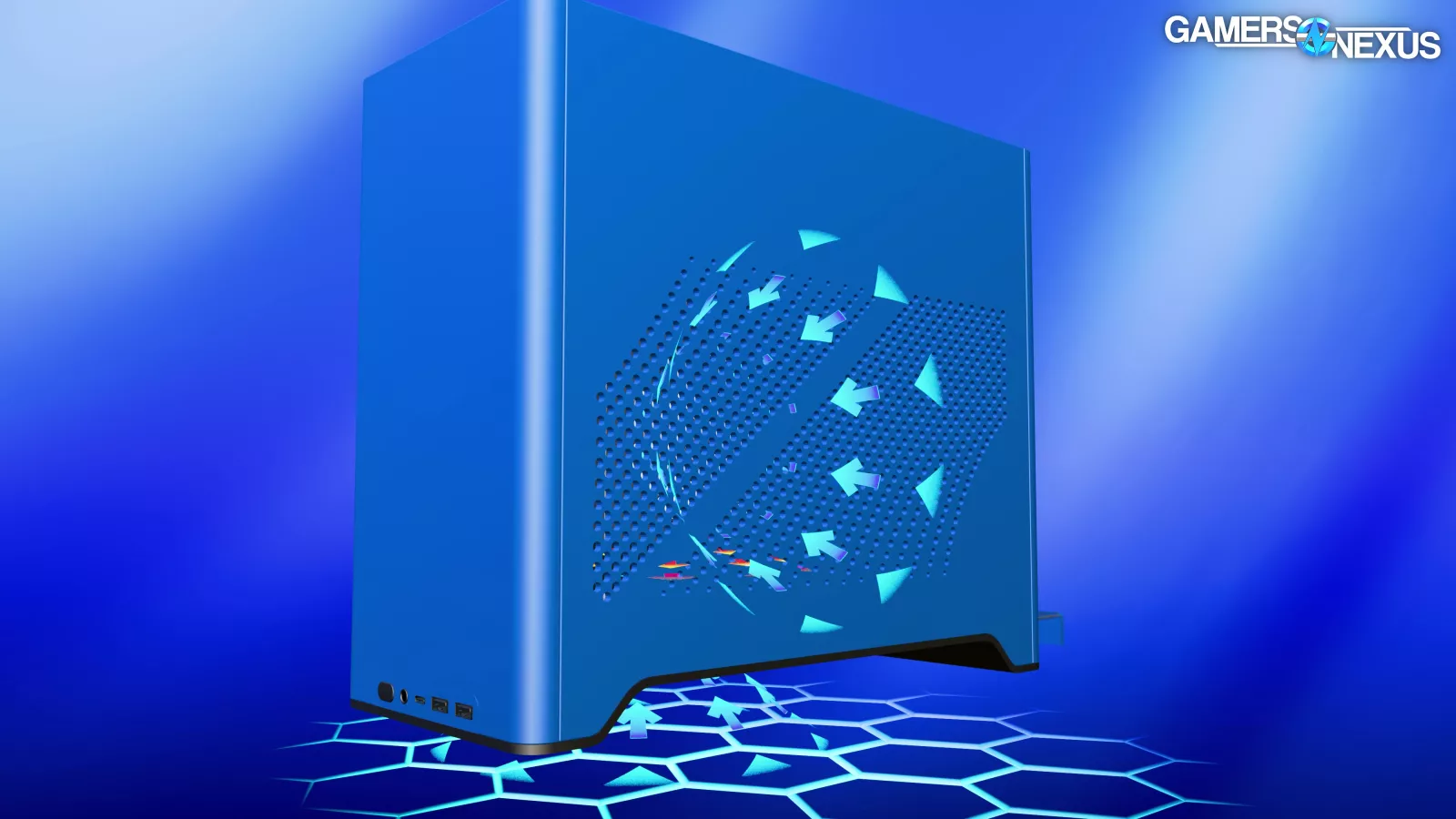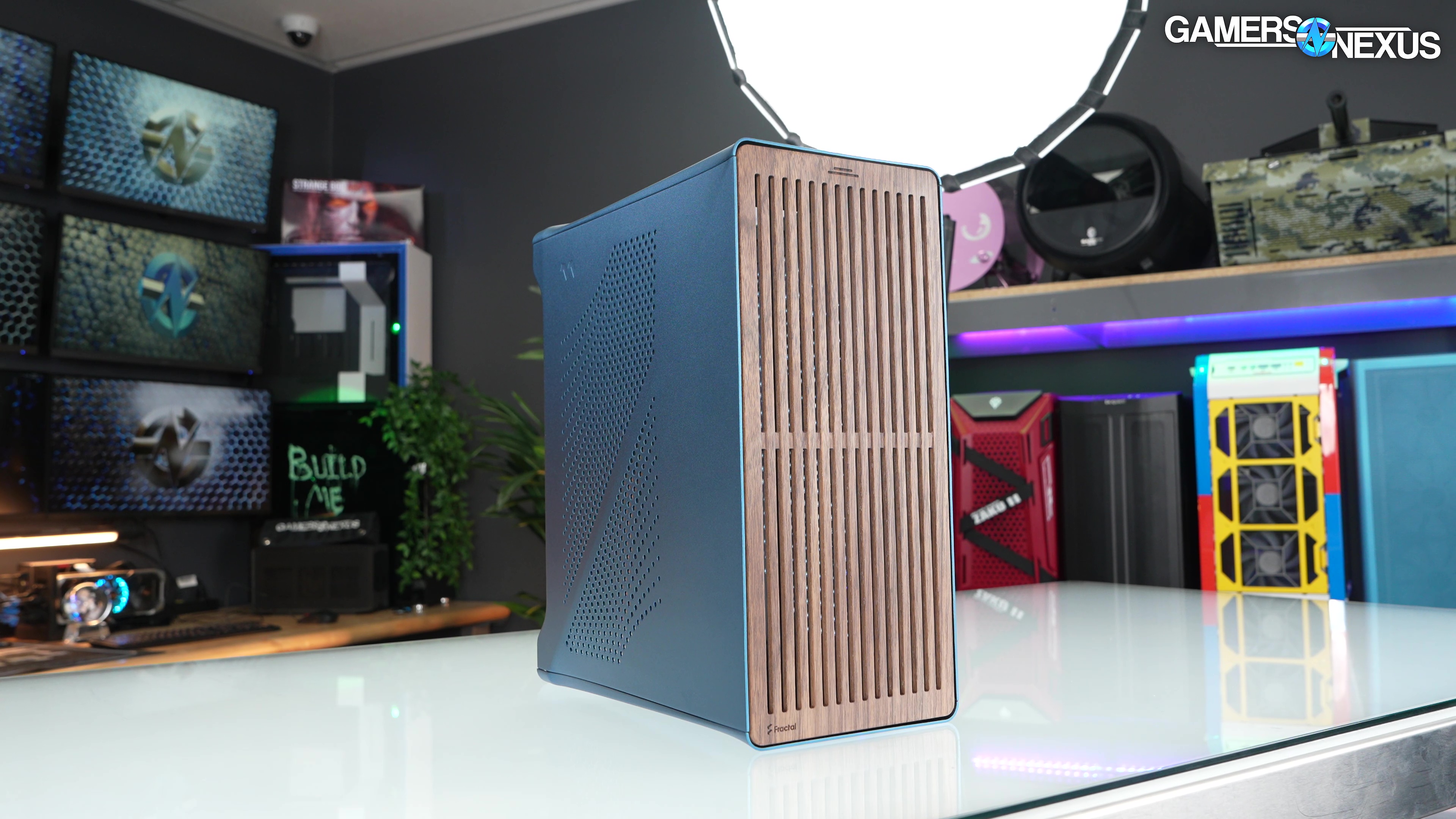
Fractal's Excellent Era 2 Case: Review, Thermal Benchmarks, Cable Management, & Quality
Last Updated:
We review the Fractal Era 2’s design, thermals, airflow, and more
The Highlights
- Fractal’s Era 2 is an ITX case that features an aluminum exterior
- The walnut wood panel on our Era 2 came cracked
- Fractal’s Era 2 is a well-executed case that’s heavy on mechanical features
- Original MSRP: $200
- Release Date: September 18, 2024
Table of Contents
- AutoTOC
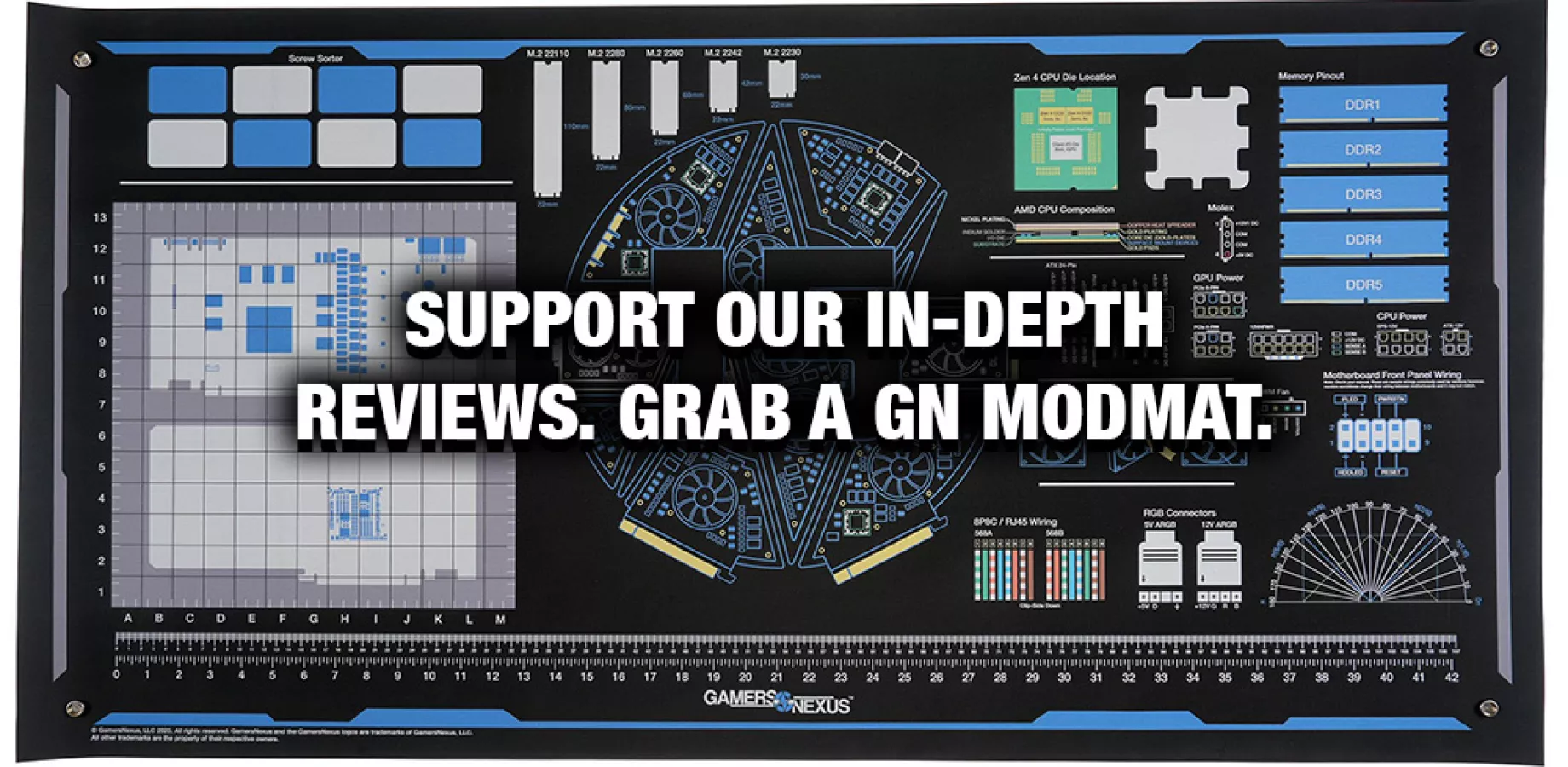
Intro
The brand new Fractal Design Era 2 ITX case is heavy on the mechanical features.
The entire case disassembles without screws or traditional snaps: Its walnut panel pops up on press, its dust filter acts as a locking mechanism for its shell, and then its shell removes in a single piece on slides. Its spring-loaded latches release the radiator mount to fully open up the case for building, and 4 screws can be loosened to move the central spine between 3 positions to trade-off between GPU and CPU cooler clearance. There’s also a single screw that controls a rail-mounted dual SSD cage.
But the case also does some weird things and has some problems: For one, our wood panel is cracked. This is primarily concerning because it’s a point that Fractal really pushed when it unveiled the case, stating that it had a reinforcement that specifically prevented cracking. Second, the PSU exhaust and bottom intake are in conflict with each other.
Editor's note: This was originally published on September 18, 2024 as a video. This content has been adapted to written format for this article and is unchanged from the original publication.
Credits
Test Lead, Host, Writing
Steve Burke
Testing, Writing
Jeremy Clayton
Camera, Video Editing
Vitalii Makhnovets
Camera
Tim Phetdara
Writing, Web Editing
Jimmy Thang
We made another 3D airflow animation to help explain the configuration that Fractal created where the power supply fan is fighting the intake fans. We’ll talk about this down below.
So, it’s mechanically complex and costs $200. We’ll go over build quality and thermal performance in this review.
Fractal Era 2 Overview and Competition
Let’s go over the basics and competition first.
The Era 2 comes in blue, black, or silver and is a sandwich-style ITX case. The case has two pre-installed fans in the bottom for intake, room for a 240mm or 280mm liquid cooler in the top, and a continuing trend of higher cost ITX cases. A good portion of that cost is probably tied-up in the stylized aluminum shell and slotted walnut wood top panel.

The side panels have ventilation via a hole pattern that ranges from sparse to useless, mixing an artsy approach with at least trying to hit the basics of cooling. These holes are a good indicator that Fractal is looks-first on this case. We’ll talk about thermals later in the review.
The original Era Il ITX predecessor is a smaller case with a similar look, but also one which Fractal has openly told reviewers it felt it had underperformed on. The company is trying to fix its shortcomings with the Era 2.
Internally, the Era 2 has a lot in common with the $180 Fractal Terra. The motherboard, GPU, and PSU are in the same basic layout on a moveable spine, but the power supply is rotated 180 degrees in the Era 2. This results in the cables facing up – nice for ease of access – and the PSU exhaust facing down, which is awkward from an airflow standpoint.
Other than its own Terra, competition to Fractal’s Era 2 would include these cases:
The $150 Lian Li DAN A4-H2O, which is smaller, more rectangular, has no extra fans, and still supports a 240mm liquid cooler. A much larger and cheaper comparison would be the A3-mATX we recently reviewed, but they exist in totally different market segments. We did like that case, though. We also recently reviewed Fractal’s Mood, but would not recommend the case; its thermal performance was overall poor and some of its compatibility choices were odd. The M1EVO (watch our review) is another relatively expensive, specialized ITX case you could look at.
Fractal Era 2 Dimensions and Fitment
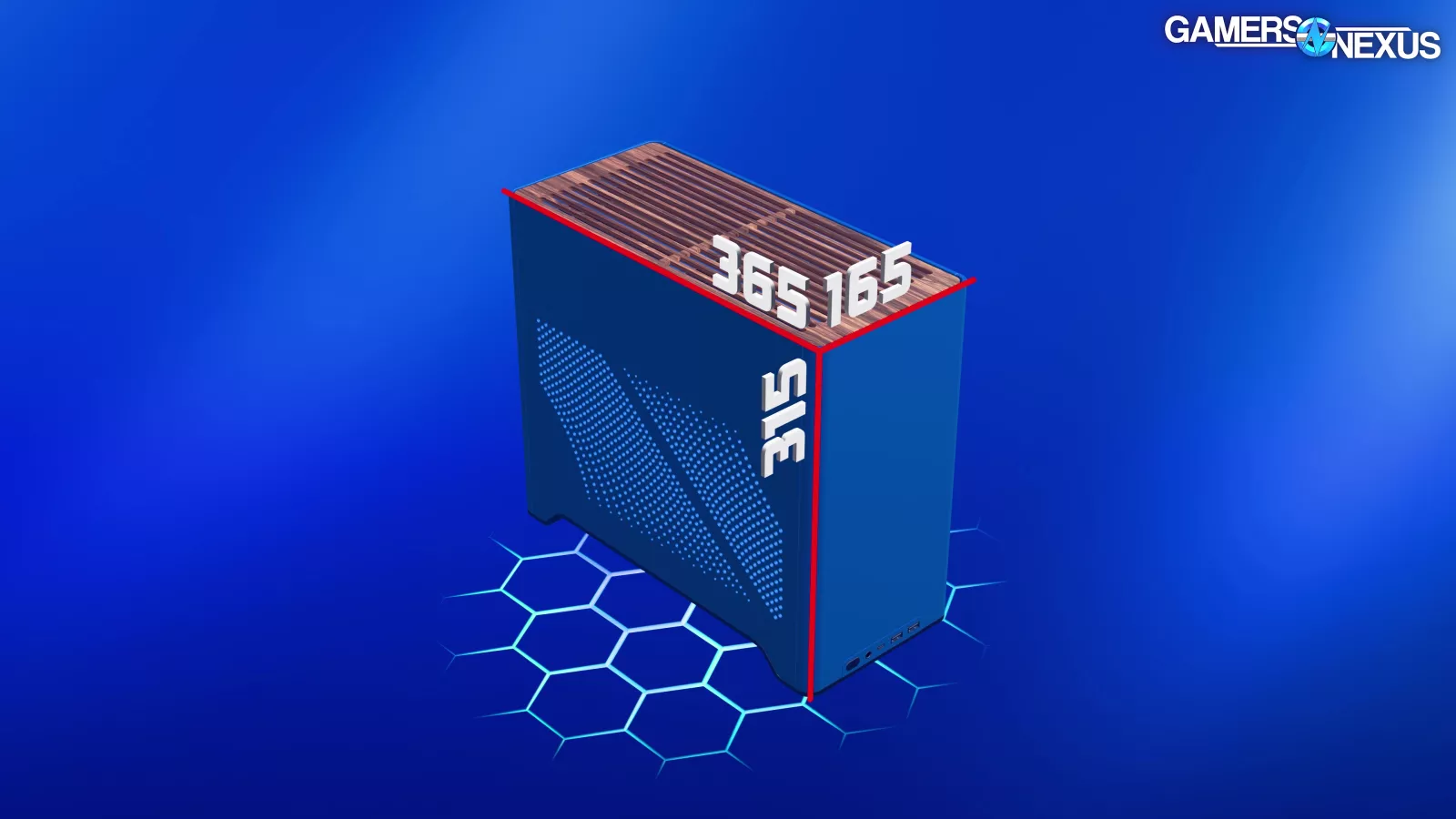
Getting into the dimensions and compatibility: The Era 2 is 365mm long, 165mm wide, and 315mm tall, which calculates to a 19L volume and is nearly spot-on with Fractal’s own measurements.
If you’re keeping track of our ITX reviews at home, add one more to the tally for “not lying on the spec sheet.” That’s not as common a tally as it should be.
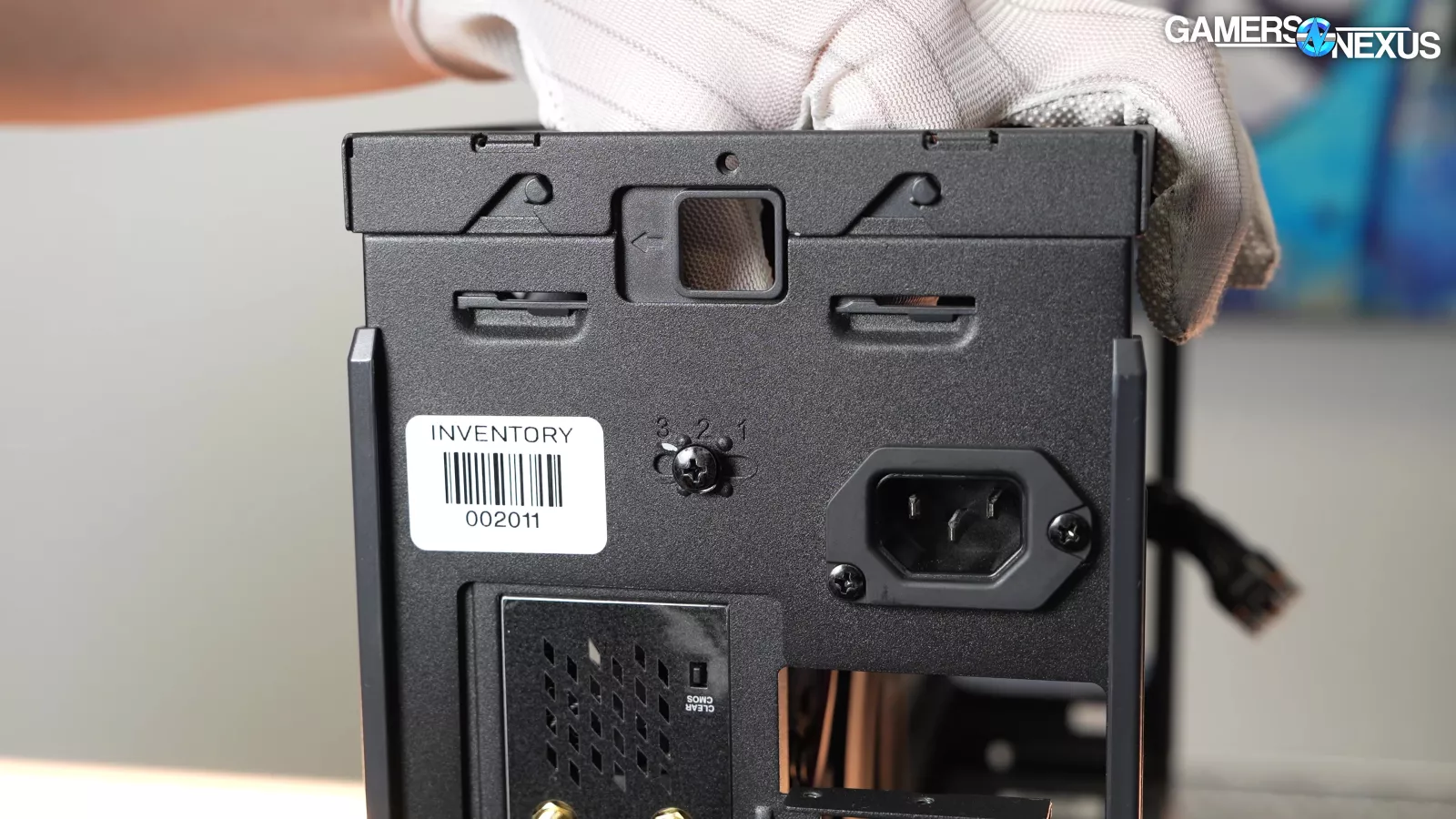
The movable spine has a major impact on internal fitment and can be set to three predetermined, stepped positions. This is a big difference from the stepless nature of the Terra’s spine adjustment.
Position 1 gives the most CPU-side clearance and fits up to 70mm tall coolers while reducing GPU-side clearance to 48mm (or just 2.4 slots) of available thickness. Position 3 changes those values to 55mm for the CPU side and 63mm (3.1 slots) for the GPU.
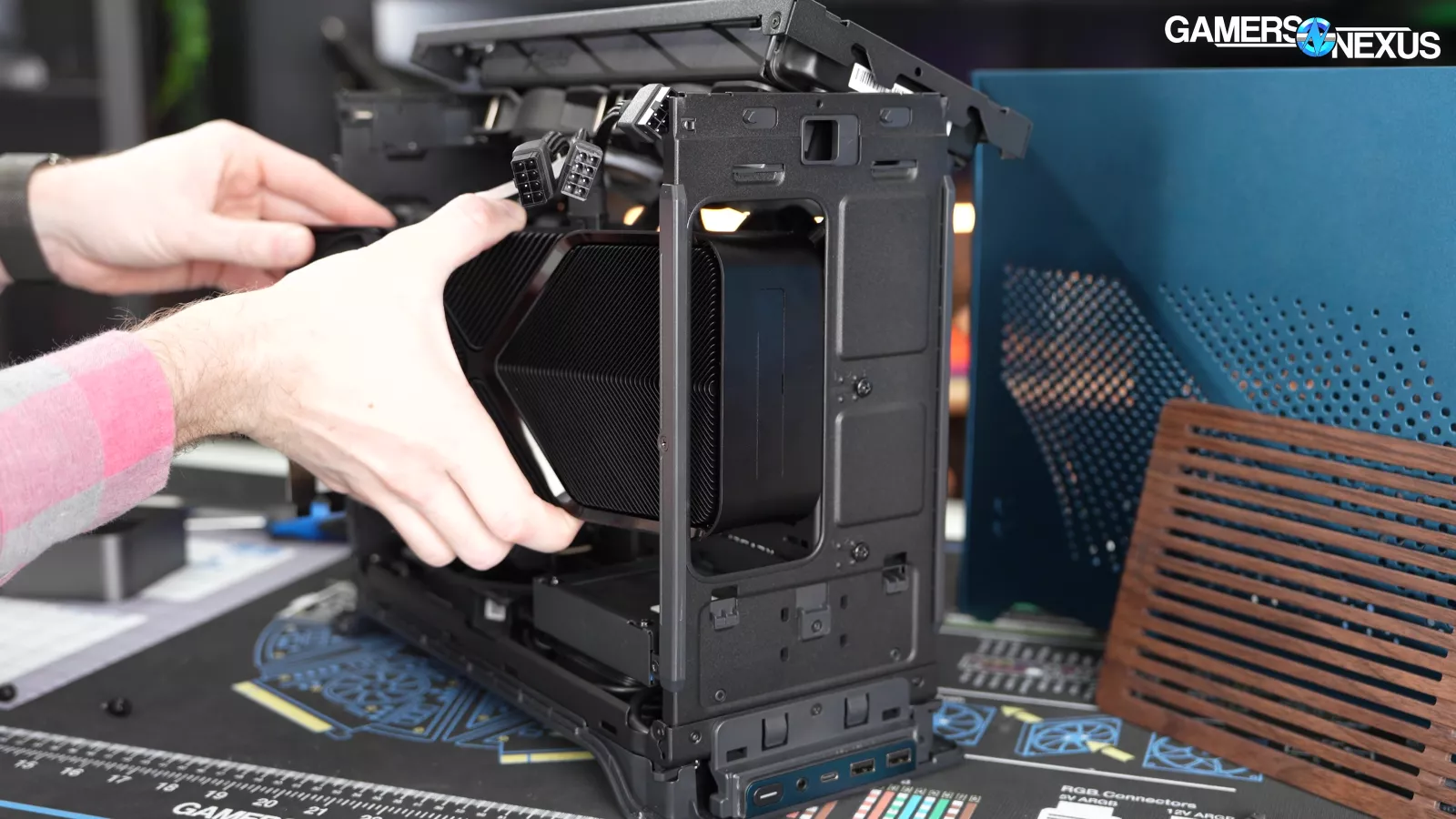
Maximum GPU height is 137mm regardless of spine position, but you’ll want to be aware of the cable bend also. Fractal recommends a max GPU backplate thickness of 4mm. Bear in mind that larger GPUs will restrict air movement within that side of the case and power cable management can become problematic with larger cards. As always, just because it fits doesn’t mean it is a good fit.
As another point of reference, the RTX 4080 FE fits, but will have its flow-through cooler heavily limited due to having only 11mm of clearance behind the card in spine position 3. So we’re back to “it sort of fits” but isn’t necessarily a good choice.
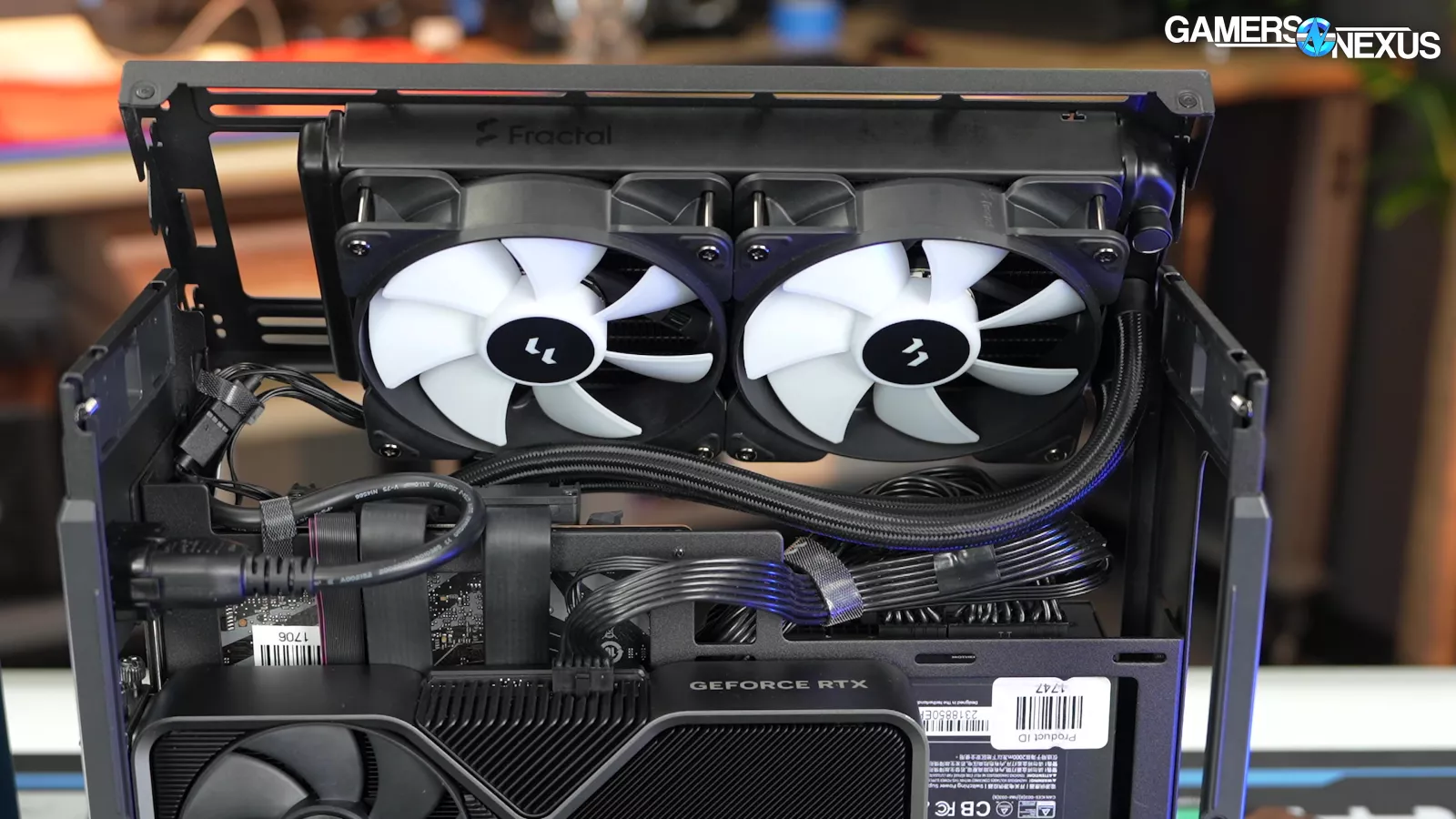
For cooling: The top bracket can hold 280mm radiator and fan combos up to 52mm thick. 240mm liquid coolers can be slightly thicker depending on exact placement, but will quickly encroach on power cables and their own tubes.
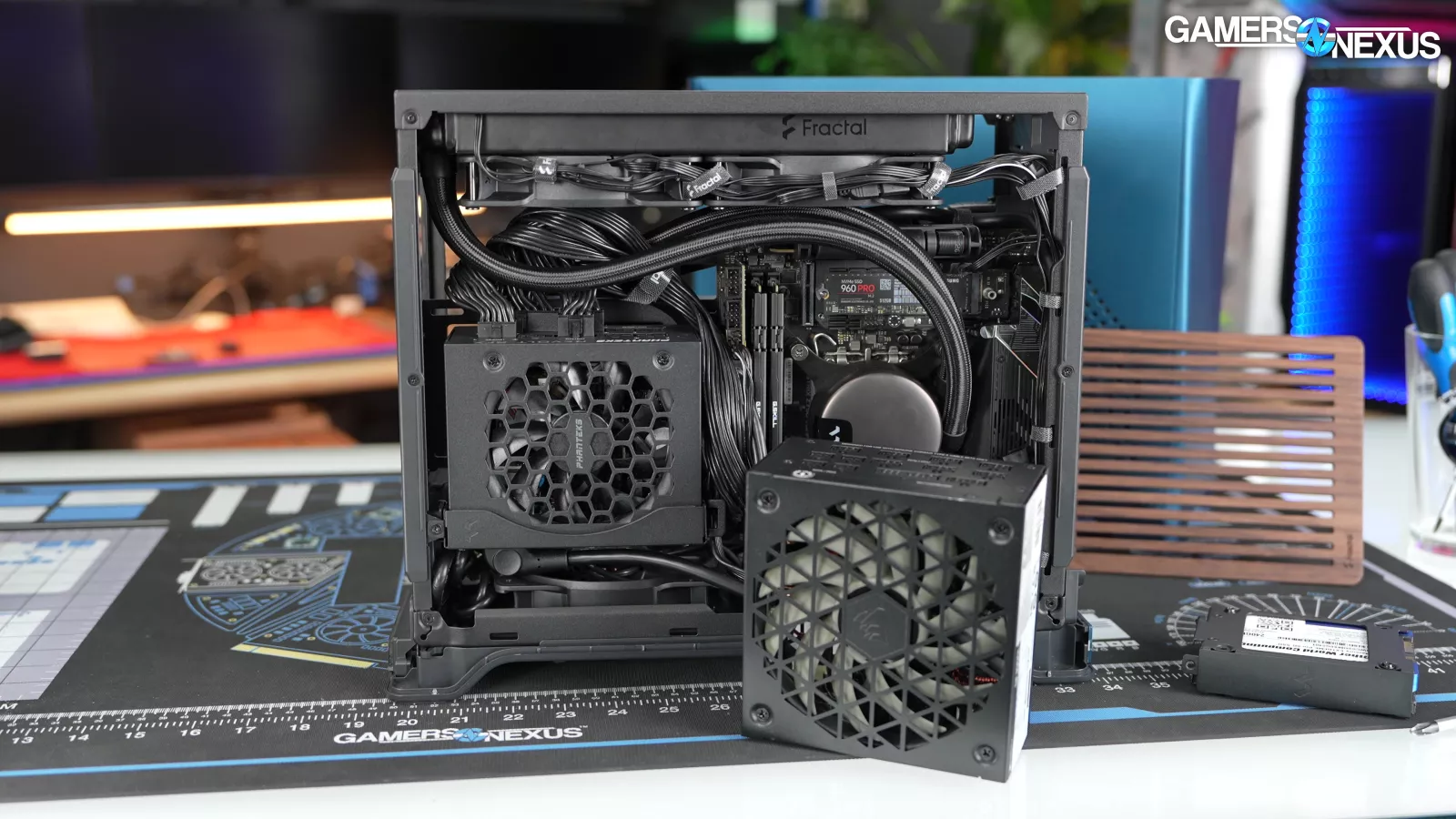
Both SFX and SFX-L PSUs are supported. Space for cables is greatly hampered by SFX-L, so we’d favor standard SFX.
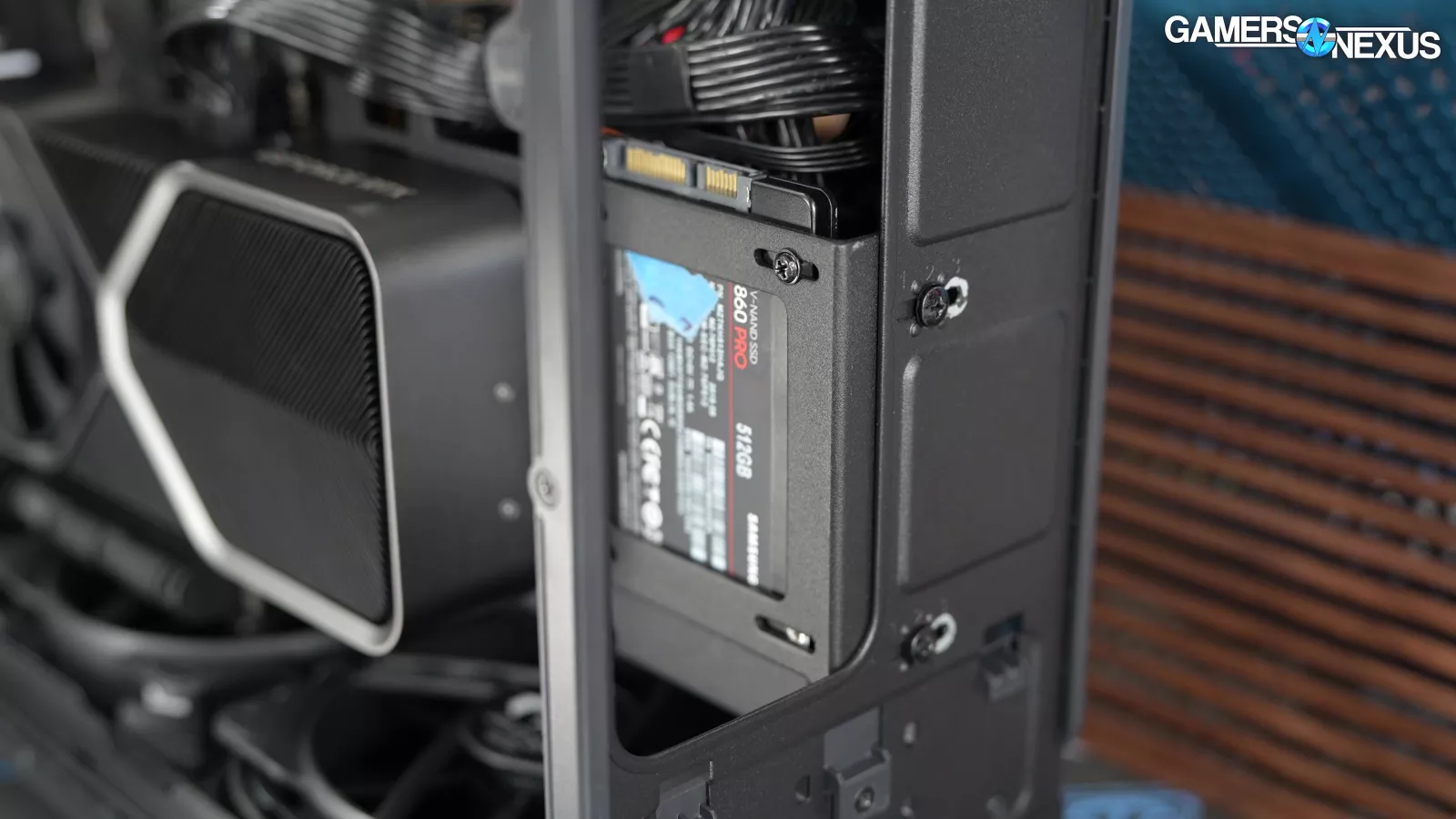
Internal drive support is pretty good for the size. There are 4x 2.5” mounts in total – two in the rail-mount drive cage (blocking off a large portion of the intake fan below it) and two on the spine behind the PSU, though are only usable with the spine in positions 1 and 2, and would be detrimental to flow-through GPUs. 3.5” drives are not natively supported in the case.
The Build - Positives
Time to run through positives and negatives. We’ll start with positives.
There are a lot of things the Era 2 does right, and the build process was relatively straightforward for ITX standards. The top radiator mount was a major help, as was the PSU orientation with the internal terminals facing up. Accessibility overall is excellent, which is a major factor in ITX cases.
The GPU side of the case is essentially wide open, and a cutout at the front helps with installation of the longest supported GPUs. You’re able to angle the far end of the card into the hole first, then move the PCIe slot side into position.
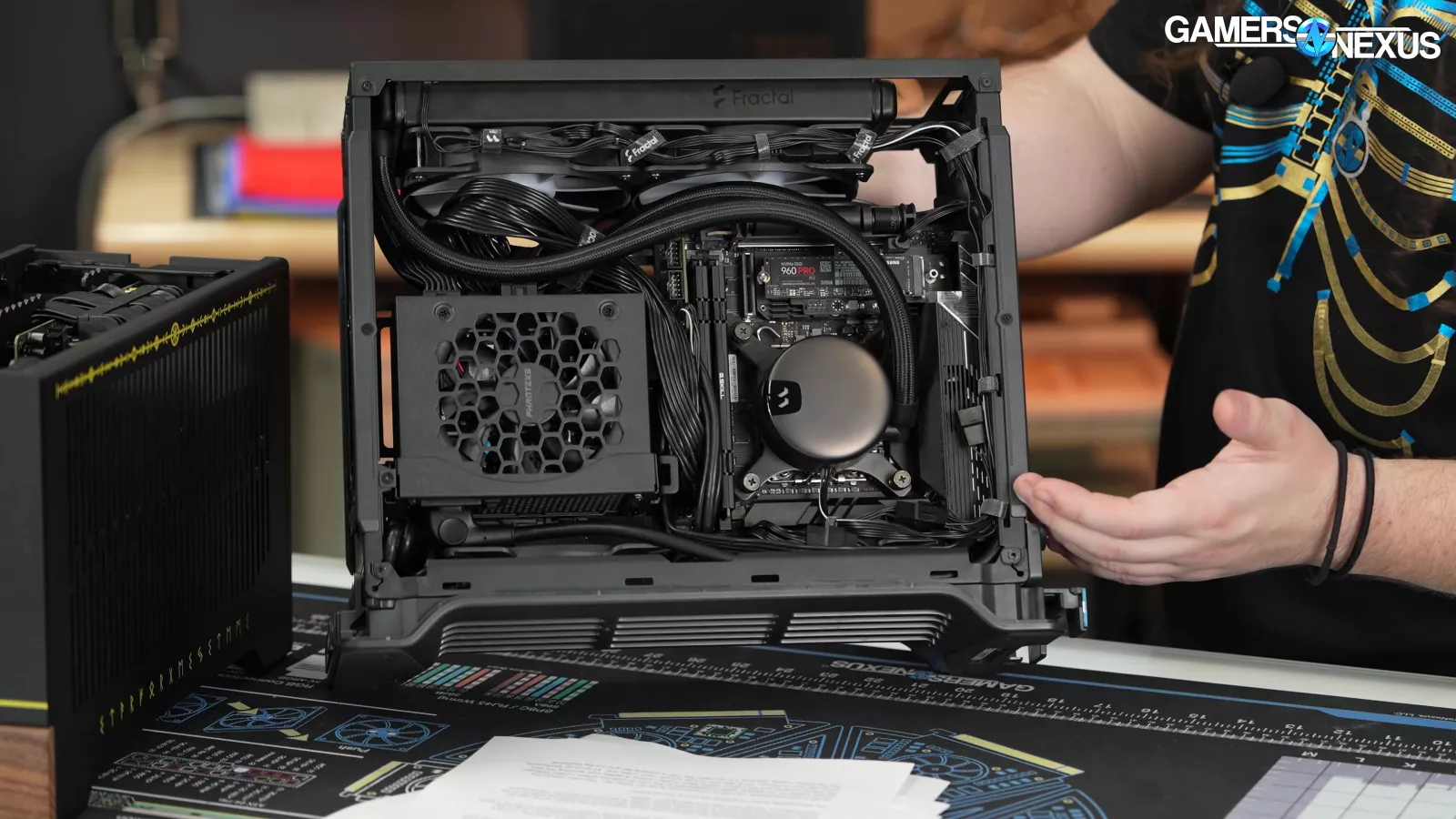
Cable management is also excellent overall and is one of the most difficult things for an ITX case to accommodate successfully. There are tie-down points and small channels for cables everywhere – like around and in between the bottom fans. Even in the most GPU-biased spine position (3), you end up with just enough space around the edge of the motherboard to get the job done tidily for cable management. The manual is also well-made and offers actually helpful cable management tips.
Fractal’s attention to detail in the design of the Era 2 is overall great, as it was able to make an objectively complex case remain easy to use through thoughtful engineering.
There’s a number of other small features that we thought were well done. To quickly go through them:
- Tapered plastic rails at the front and rear ensure that sliding the shell on/off is smooth
- A slight inward angle along the bottom interior edges to help keep cables tucked in
- Flared leading edges on the rail interface for the drive cage and PSU bracket are well done
- The opening at the front of the internal chassis to assist with long GPU installation is rounded over to be completely smooth
- A small strip of fabric glued to the top edge of the front I/O to keep the aluminum from rubbing
- The dust filter doubles as the lock mechanism, causing two spring-loaded plastic lugs at the front to pivot into place
- A bowed-down filter at the bottom to match the bowing of the underside of the case, which Fractal claims gives better access to air
The Build - Negatives
Moving on to the negatives, one of the only difficult aspects about the build was access to the motherboard’s top edge. Since it’s inverted in the Era 2, it ends up down at the bottom. You may want to pre-connect cables there before installation or get comfortable with using a plastic spudger to poke them on after the fact.
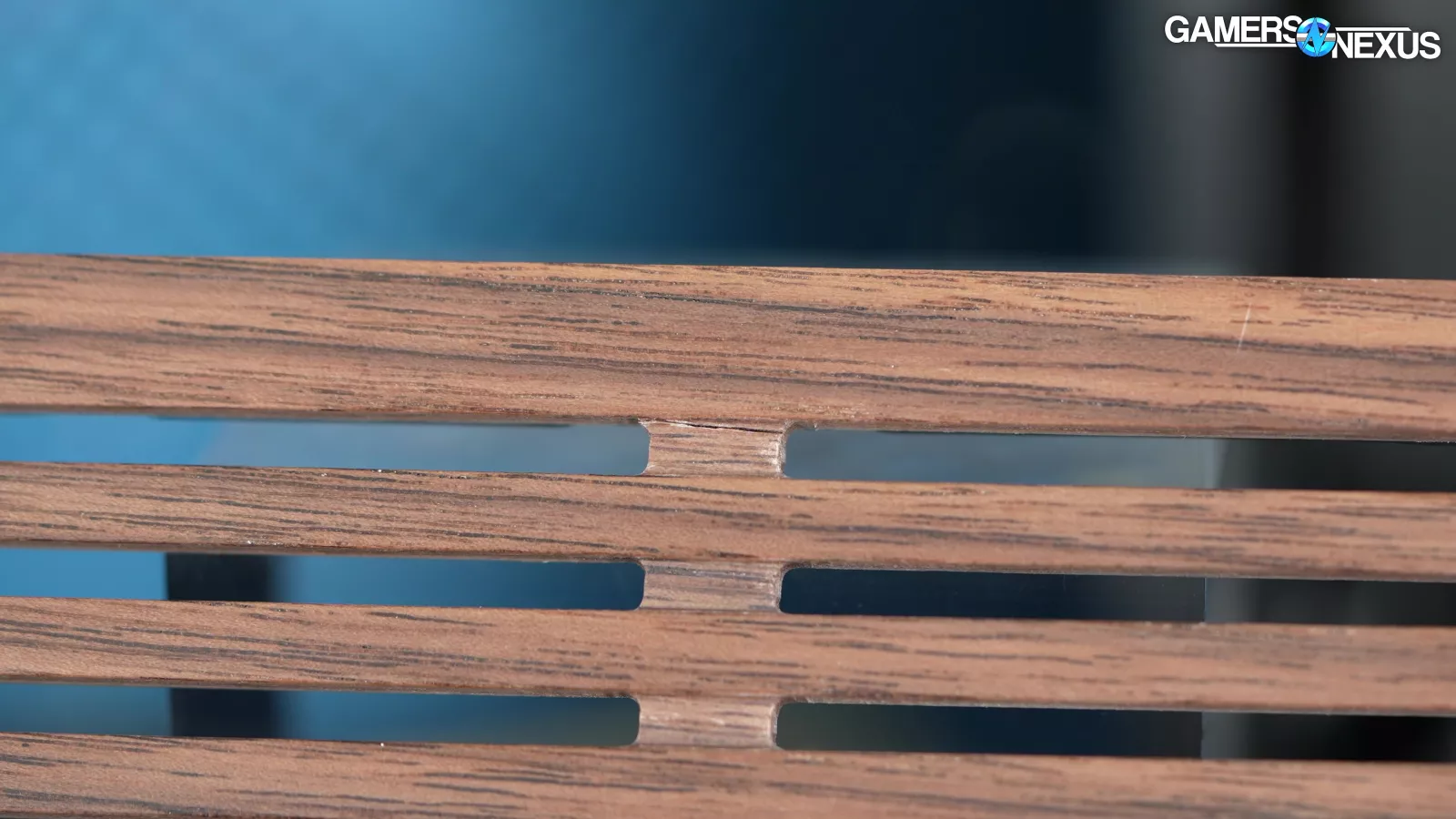
The wood top panel on our sample is cracked in one place between the edge and the interior slats. We don’t know at what stage the wood cracked -- possibly at the factory or maybe in storage and shipping as it crossed climates, humidity, and temperature gradients. Either way, wood is a relatively sensitive material, and this makes us concerned about the durability of the part, despite the steps Fractal took to reinforce it. Fractal emphasized in its early meetings that it was reinforcing this panel with metal to prevent cracking in a way that seemed like shots taken at competition, but now we wonder if it was actually because of their own experiences. Using two separate pieces of wood might have avoided this, despite creating a seam. This isn’t extremely noticeable, but it is disappointing.
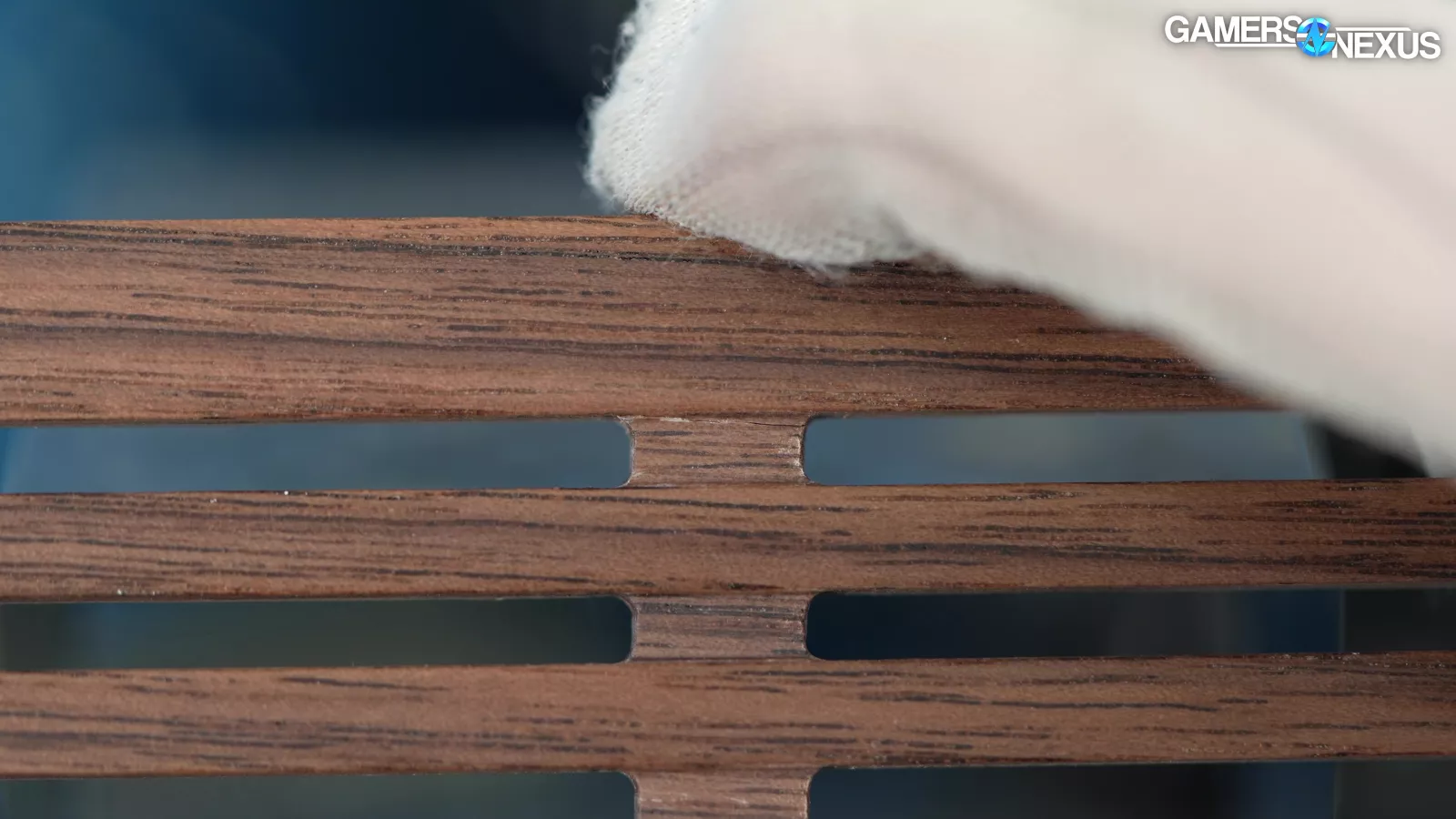
By pressing the sides together, we see the crack fit perfectly back into place. This makes us think that Fractal may be better off with 2 crossbars rather than one, as it seems like the wood curing and aging may have pulled apart horizontally. Another crossbar to hold the sides uniform to each other might help.
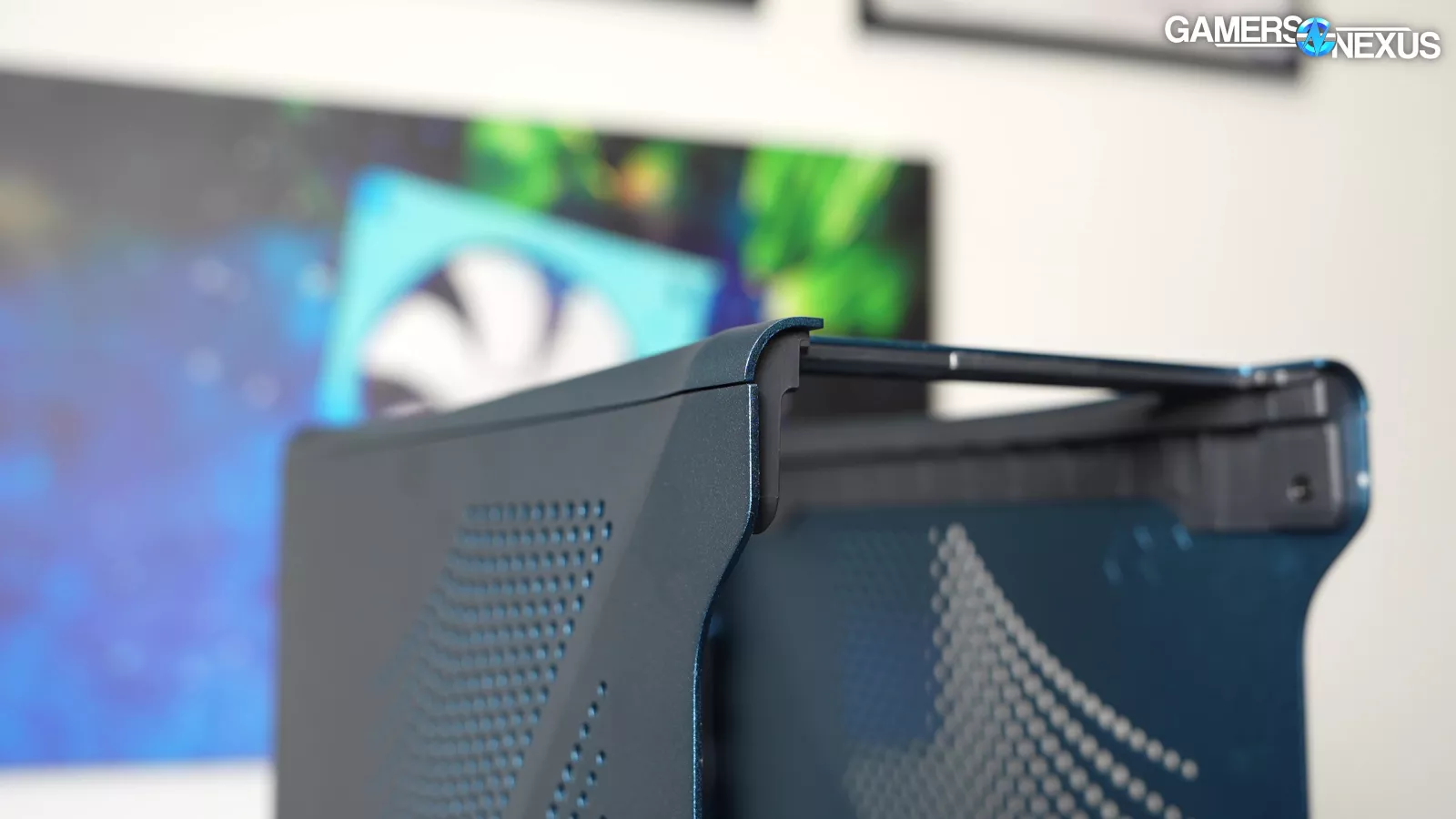
Also in the realm of build quality, one of the side panels on our sample is Tesla-like, in that it doesn’t line up perfectly with the panels around it, resulting in a visible jump from one to the other. These are both QC issues at the core, and are things Fractal should definitely look out for on a $200 case.
A final minor annoyance is the fact that the shell has a crossbar at the bottom of the rear I/O area, meaning that you have to remove all of the cables before you can slide the shell on or off. Fractal could have built this in a way where it’d be easier to get into the case for maintenance without that bar, though this may be a sacrifice for rigidity.
Fractal Era 2 Airflow
For the potential airflow downside, we turn to our animation.
As we mentioned before, the PSU’s exhaust side faces the intake fan. The case orients the power supply for the easiest cable management at the cost of potential airflow conflict between the PSU’s exhaust and the bottom intake. Most modern power supplies stop spinning the fans when load isn’t sufficient, so at idle, this should actually work pretty well. It’ll force air “backwards” into the power supply, allowing it to flow past the PSU’s passive fan and out the traditional “bottom” of the power supply. That air will then exit through the perforations in the side of the chassis. That much is good. When the power supply fan becomes active, it’ll suddenly directly fight the force-fed air from bottom intake, and it’s likely that bottom intake will overpower the power supply fan. There’s enough of a gap where it won’t cause major problems, as opposed to a directly attached opposing fan, but this could still be sub-optimal for some power supplies. It’s going to be highly PSU-dependent. It’s not something we think is a critical issue, but it is one that was a little odd.
Fractal Era 2 Thermals

Now we’ll take a look at the thermal performance of the Era 2. As a reminder for anyone new to our ITX reviews, our current ITX testing methodology prohibits competitive comparisons between cases, but allows us to be much more flexible when it comes to testing a single case against itself in multiple configurations.
For the Era 2, all testing was performed with locked frequency and power on the 13600K, locked fan speed on the 4070 FE, and 100% fan and pump speeds on the 240mm CLC and case fans. We treated spine position 1 as the default, since it’s the intended setup for this size GPU.
CPU Thermals

Starting with CPU thermals, all of the tested configurations resulted in a narrow band of only 2.1C. The stock result has a slight lead with the P-cores at steady state average at roughly 45C over ambient.
Removing the top panel didn’t result in any meaningful thermal change, showing us that despite appearances, it isn’t actually restrictive to flow, at least not in this configuration.
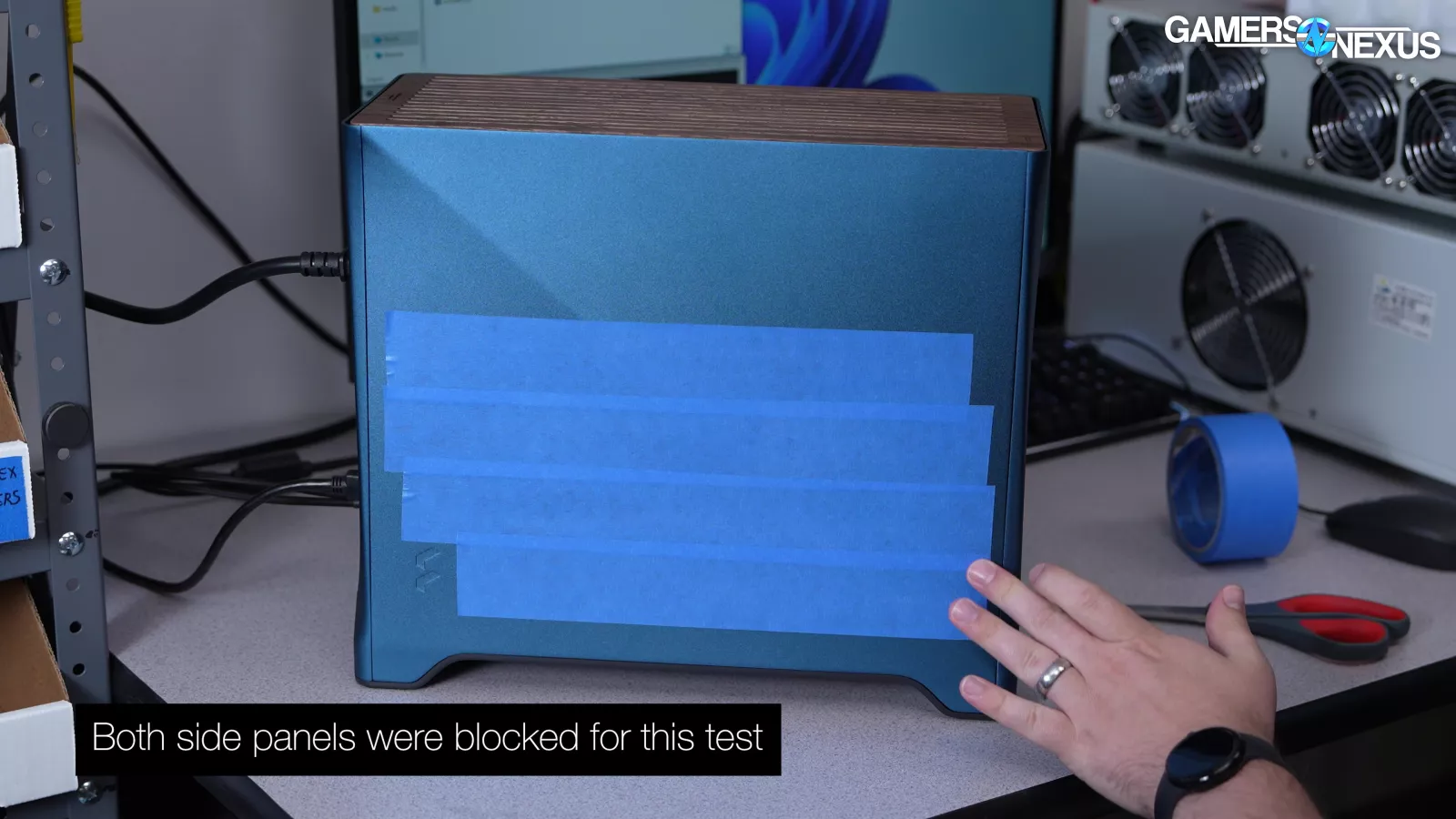
Setting the spine to position 3 hurts CPU thermals slightly, but not significantly. We were curious if the holes on the side panels actually did anything, so we covered them with tape. The answer for CPU thermals is “no,” since it’s tied with the position 3 result.
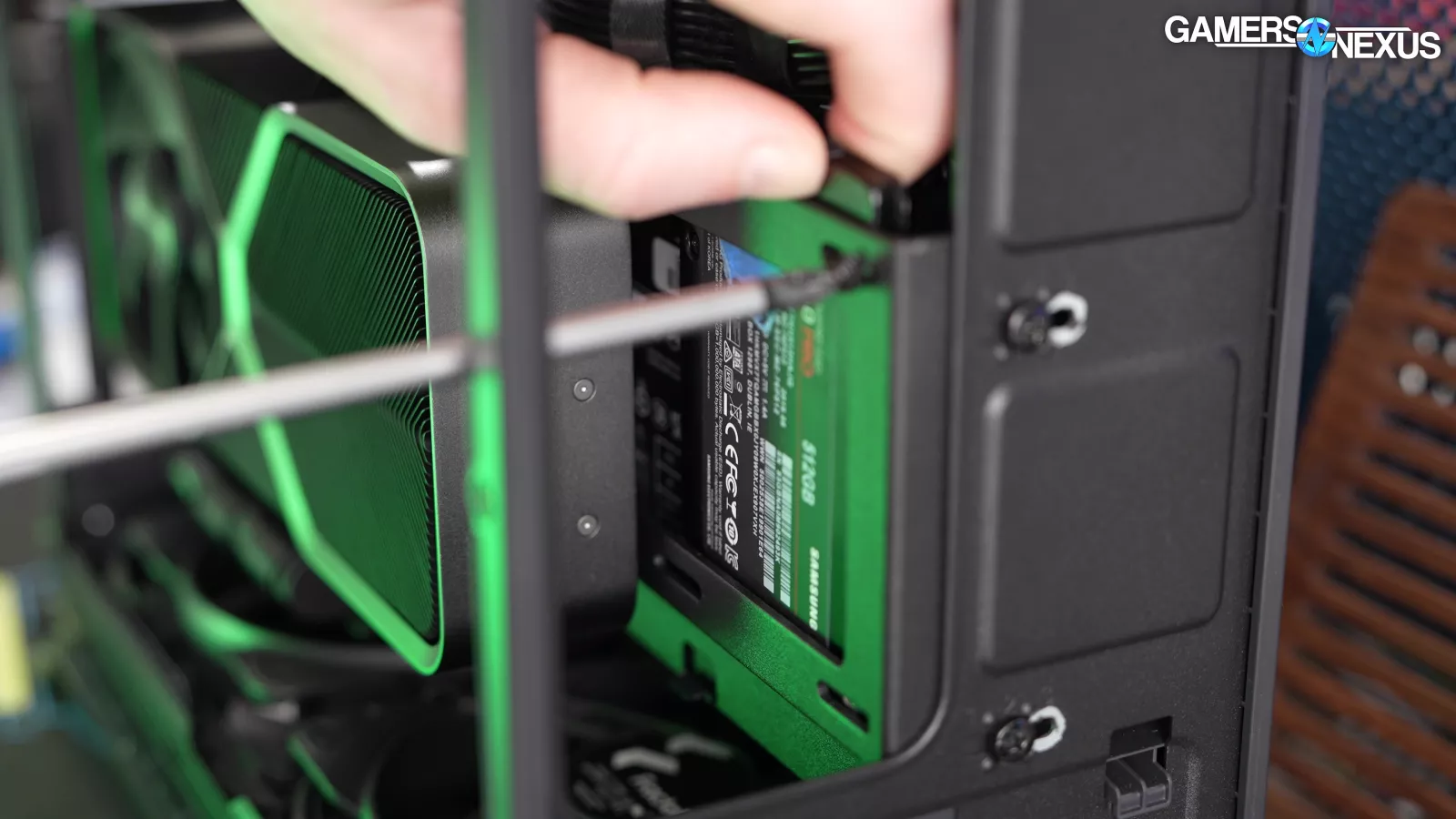
The biggest impact was from populating and installing the lower drive cage, resulting in 46.8 degrees over ambient on the P-cores. If you have just a single SATA SSD, we recommend mounting it to the forward-most spine mount behind the PSU to avoid this blockage.
Generally speaking, the two sets of fans at full speed are somewhat brute-forcing the situation, but the noise levels aren’t actually that high or unpleasant due to the fans’ middling 2000RPM maximum.
GPU Thermals

GPU thermals are next and post a wider range. Results are also consistent here and well within normal operating ranges. The stock results have the GPU die at 50C over ambient at steady state, with roughly 68C hotspot and 43C on the VRAM. Removing the top again has no appreciable effect.
The spine position 3 result isn’t meaningfully outside of variance, but suggests that keeping the GPU’s intake fans closer to the side panel is helpful.
Installing the drive cage raises core temperature of the core by about 2C, but could be further exaggerated by larger GPUs that need all the airflow help they can get.
Blocking the side ventilation and moving the spine to position 3 to allow the GPU best access to internal air shows us that the holes do actually help, as the temperature did climb.
VRM + RAM Thermals

For VRM and RAM temperatures, we see actual scaling between configurations. Everything is kept in check by the fan blasting air directly at the top edge of the motherboard.
The stock position 1 result is the best at just 20C over ambient, and moving the spine to position 3 gives the worst result. This makes sense considering the proportion of intake air is reduced on the CPU side of the case when moving from 1 to 3. Interestingly, blocking the side panel actually lowered VRM temperature by a couple of degrees. We suspect this is because taking away those exit routes forces the intake air in that region to flow only over the motherboard.
Fractal Era 2 Conclusion

The Fractal Era 2 has a great combination of features, ease of use, and performance. The single largest downside is the price. $200+ isn’t uncommon for high-end, boutique ITX, but it’s pretty steep for the mass market. A lot of that money is probably in the material choices of walnut and moderately thick aluminum, but it’s also just the ITX world.
ATX cases at this price can be really impressive too, inherently have more flexibility, and they cost more to ship. As always, ITX is all about wanting the form factor.
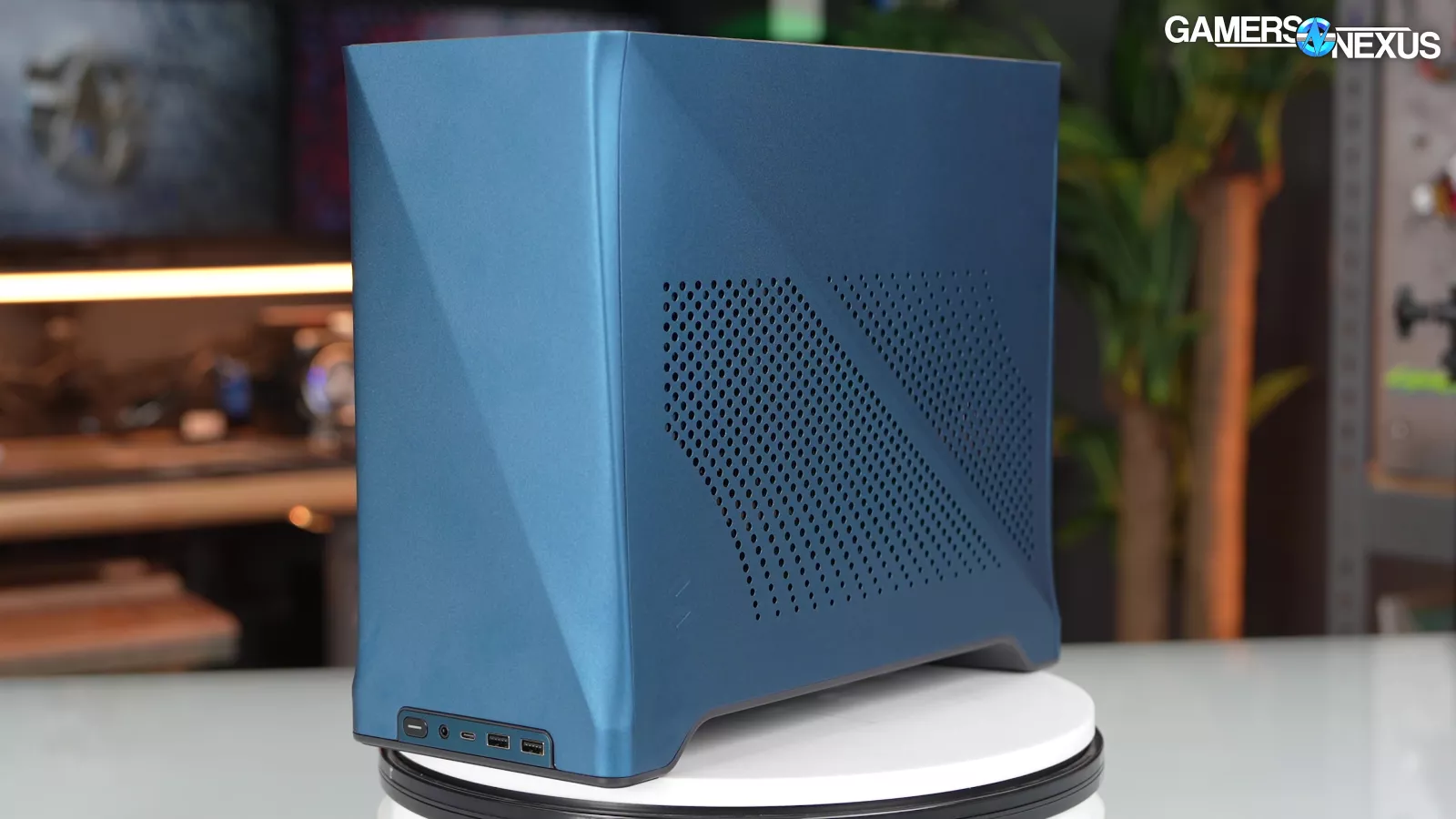
In terms of construction, we think the Era 2 displays a mastery of stamped steel as a medium. There are numerous features and fine detail touches all over the stamped parts that indicate use of complex, multi-step tooling, and nothing is left sharp. Fractal is reaching an impressive level of tooling engineering maturity.
The exterior aluminum shell and walnut top panel come off as the weakest parts in this regard, with our sample having both a crack in the wood and a misaligned side panel. This shows possible execution issues despite strong fundamentals.
Speaking of the shell, Fractal could use this as an opportunity to make visually and functionally distinct versions of the case by just making new exteriors. That opens up the avenue to do more colorways or seasonal colors going forward.
We were most impressed by the mechanical features and smart implementation of them:
- The top radiator mount is executed well
- The locking action on the dust filter is clever
- The rail system with a single screw for PSU and SSD brackets also worked well
- And the movable spine to fine-tune part fitment is improving with iterations
Thermals are good all around, despite strange PSU orientation.
The Era 2 sits at the opposite end of the spectrum from how tedious and clunky the NCASE M1EVO is. The only thing going for the M1EVO in this comparison is its extreme versatility and ability to fit even the largest of GPUs, making it still a more versatile and customizable solution, but one which we think is less refined. The versatility has benefits, but they’re for a different kind of build.
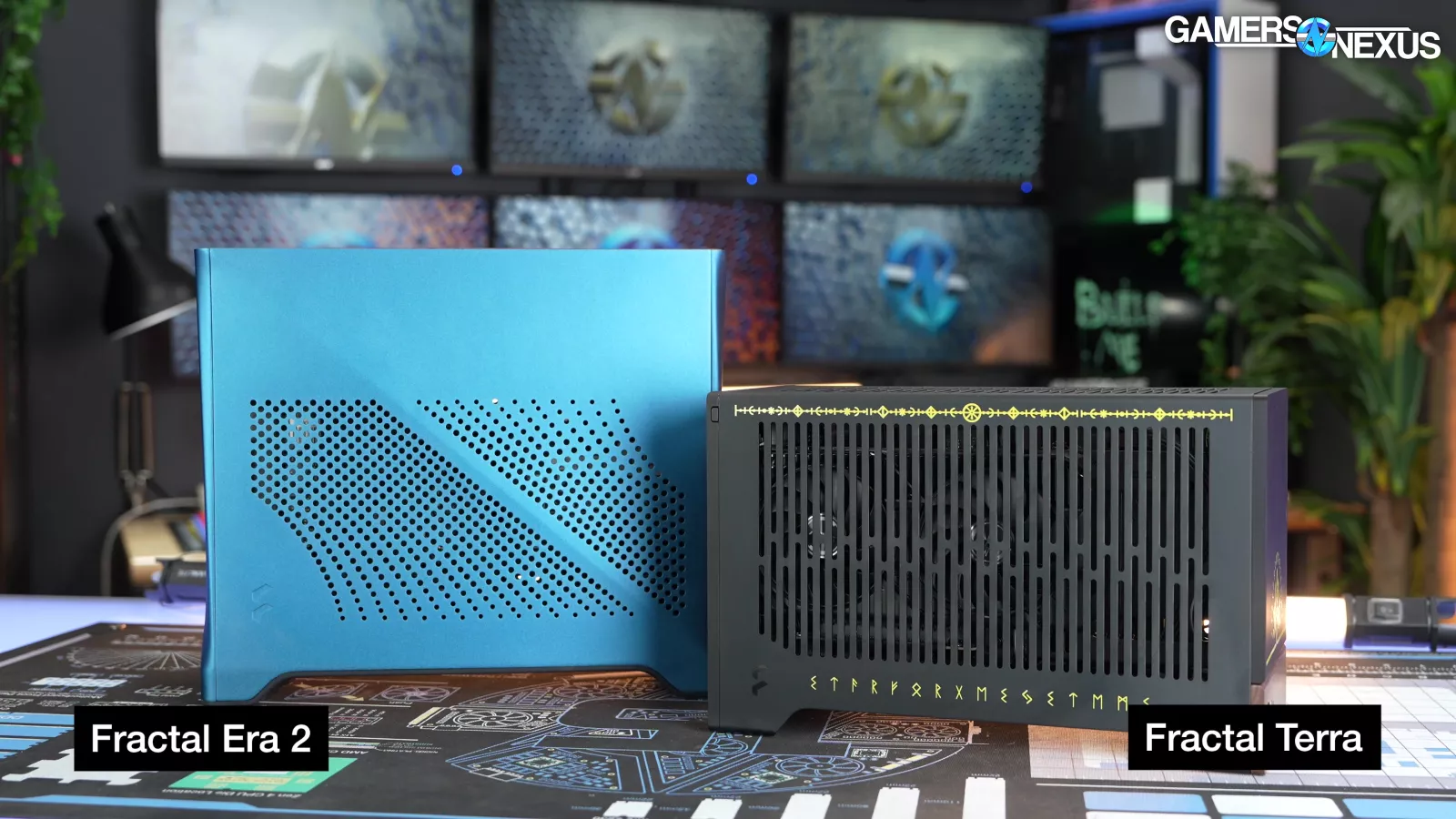
For the money, we think the Era 2 makes the $180 Terra (read our review) look less appealing on paper, since the $20 gets you two fans and much expanded capability in cooling and drive mounts. That said, the Terra is smaller and has a unique look and its own mechanical complexities that might just be more to some people’s liking. They are different enough, especially in size, that anyone who wants a Terra specifically may find the Era 2 non-viable. But if you think either could work and you’re on the fence, we’d favor the Era 2, at this point.
Those who want similar capability for less money should look at the A4-H2O, but should be aware that it’s more difficult to build in due to its reduced size.
The A3-mATX is also an excellent case (read our review) for relatively cheap (by modern standards). It’s a totally different style and not directly comparable, but you should be aware of it if you’re OK with a larger size and simpler case.
Overall, we think the Era 2 is well-executed.
